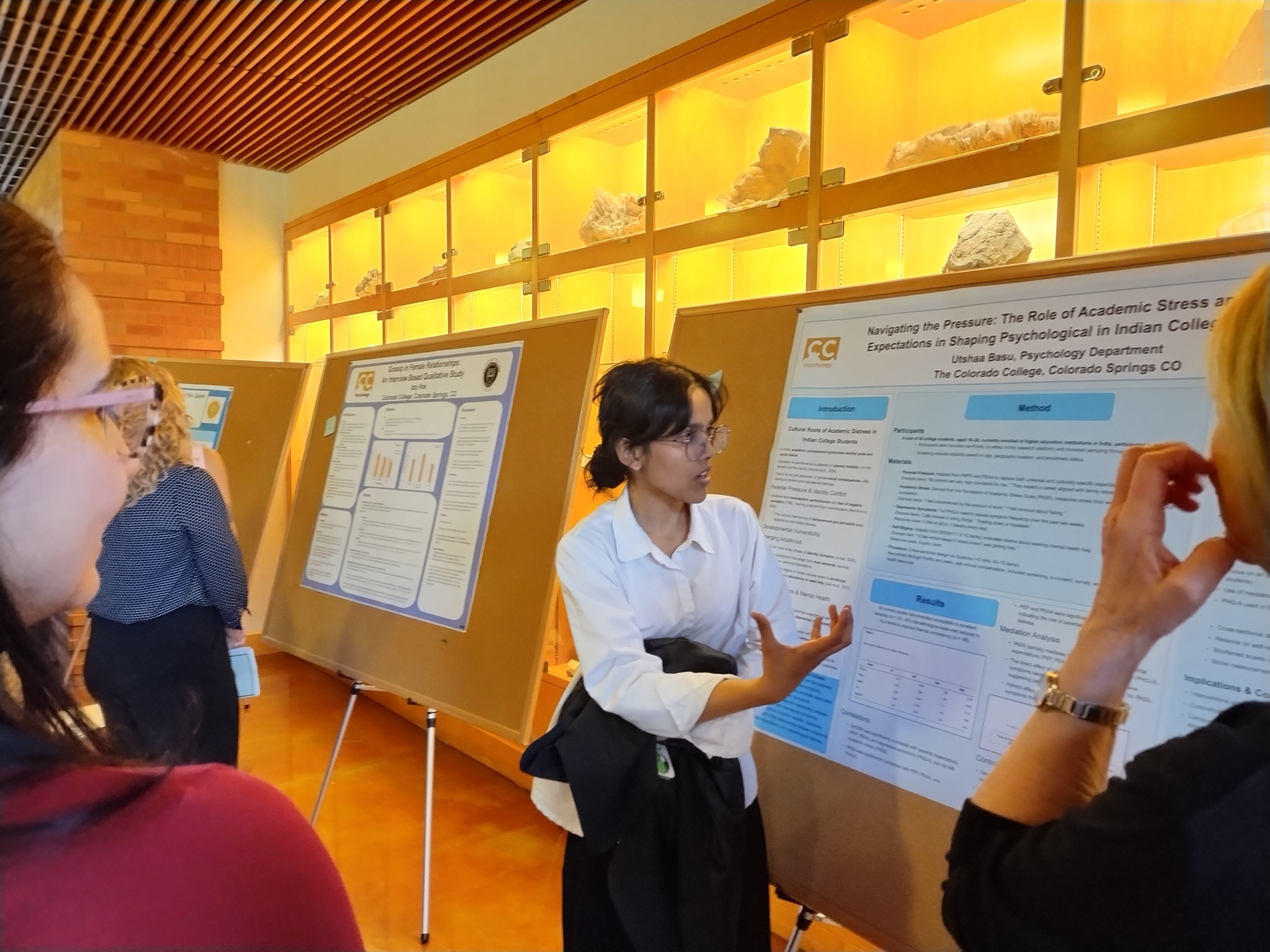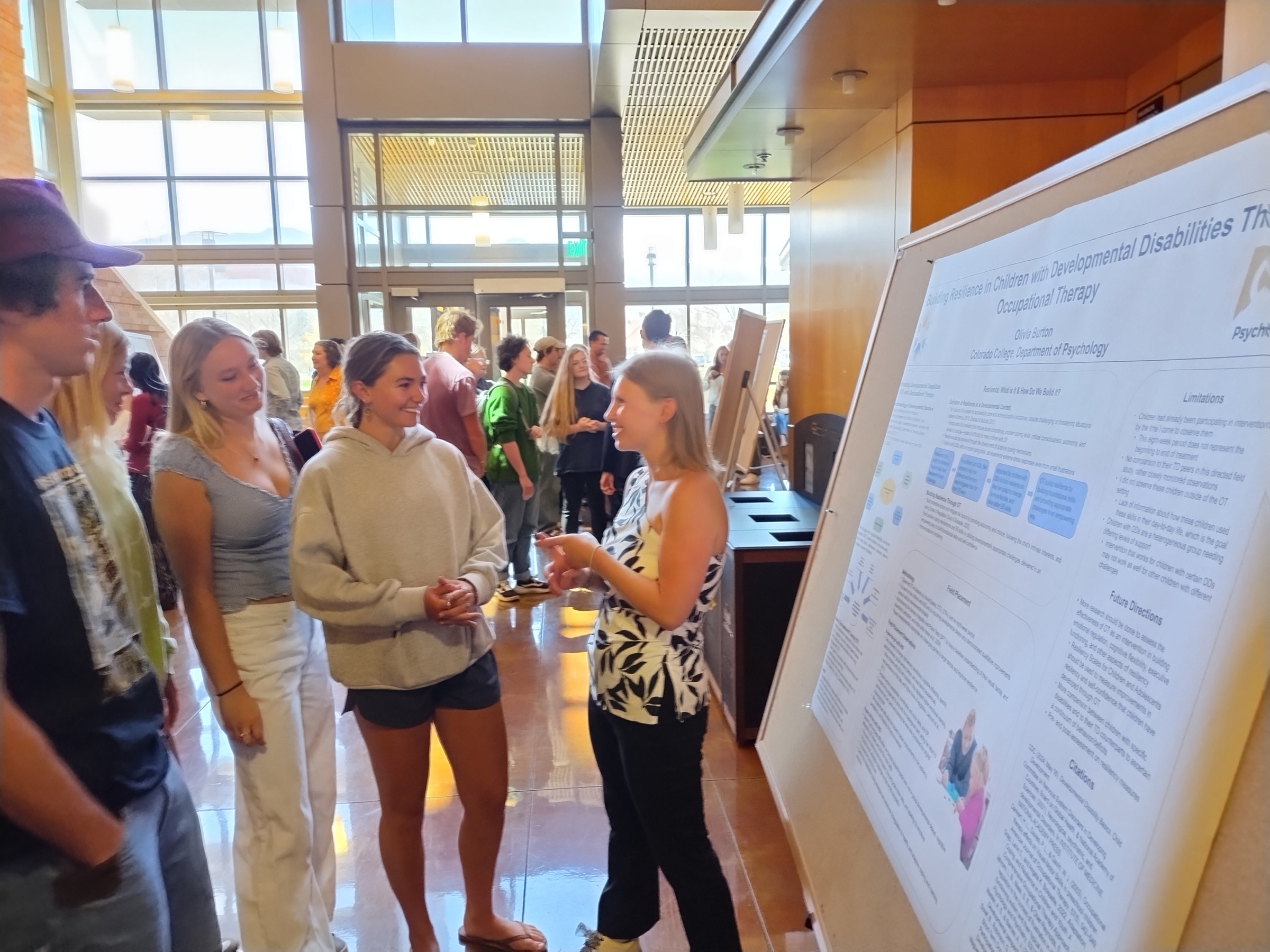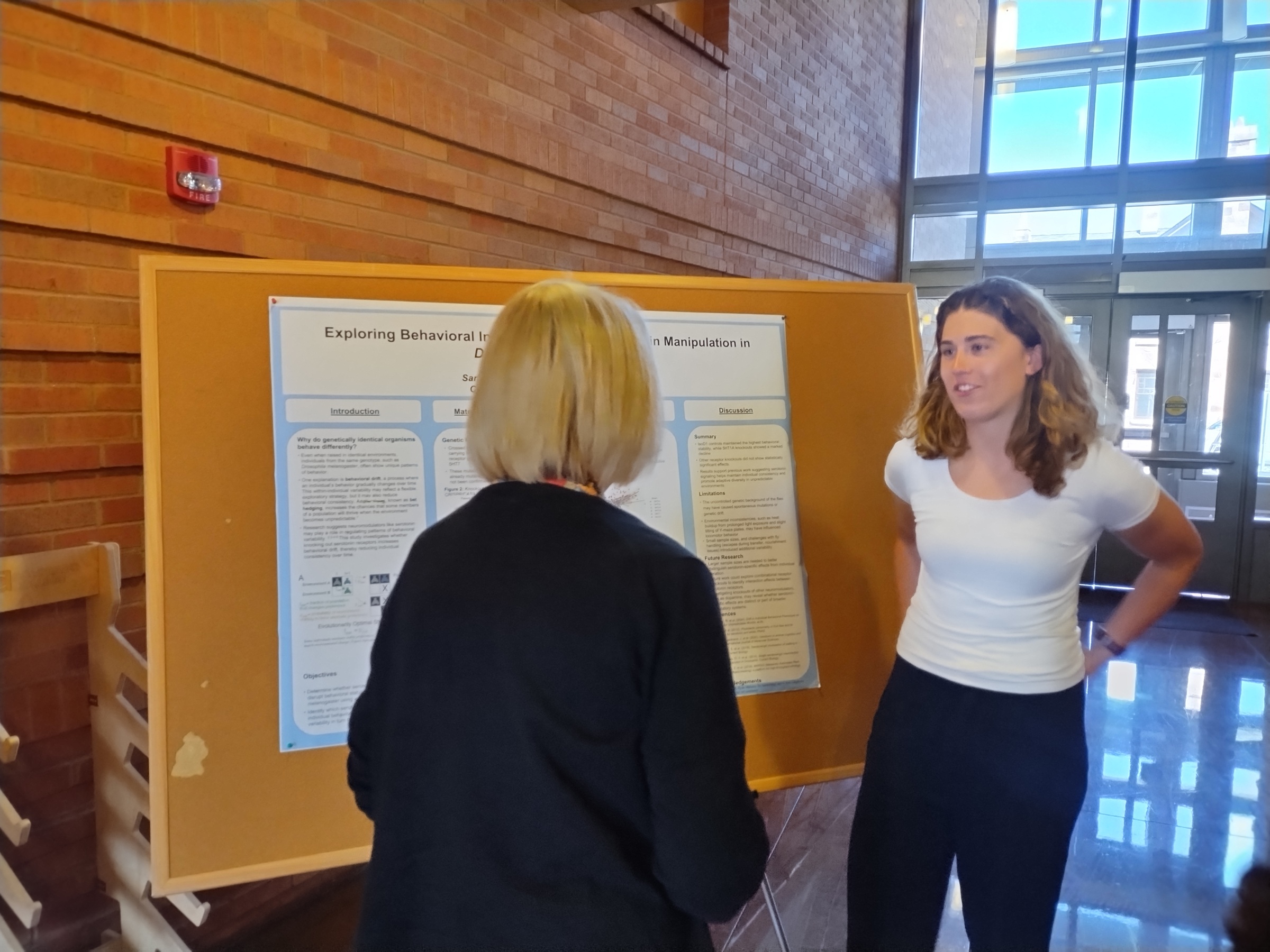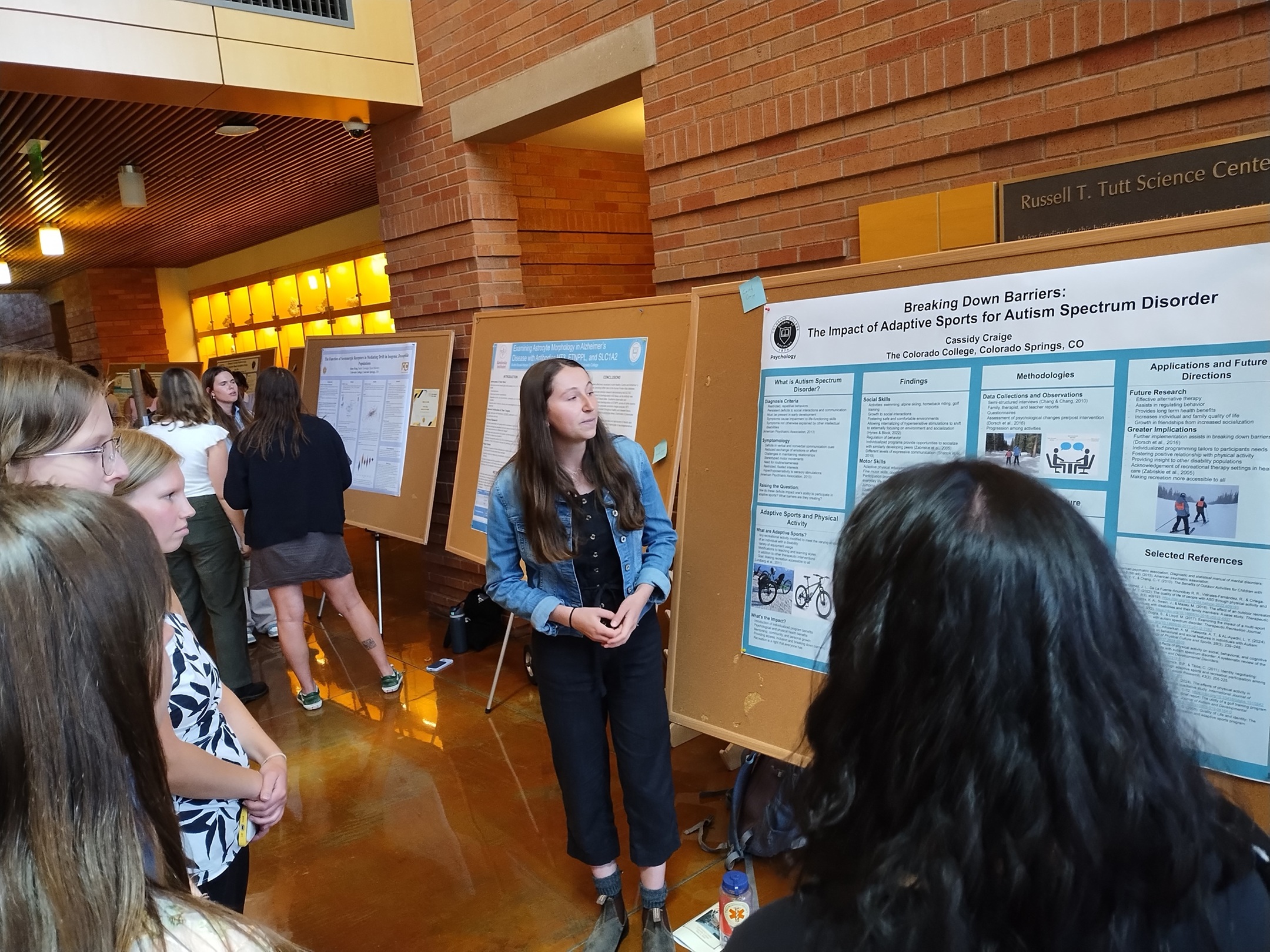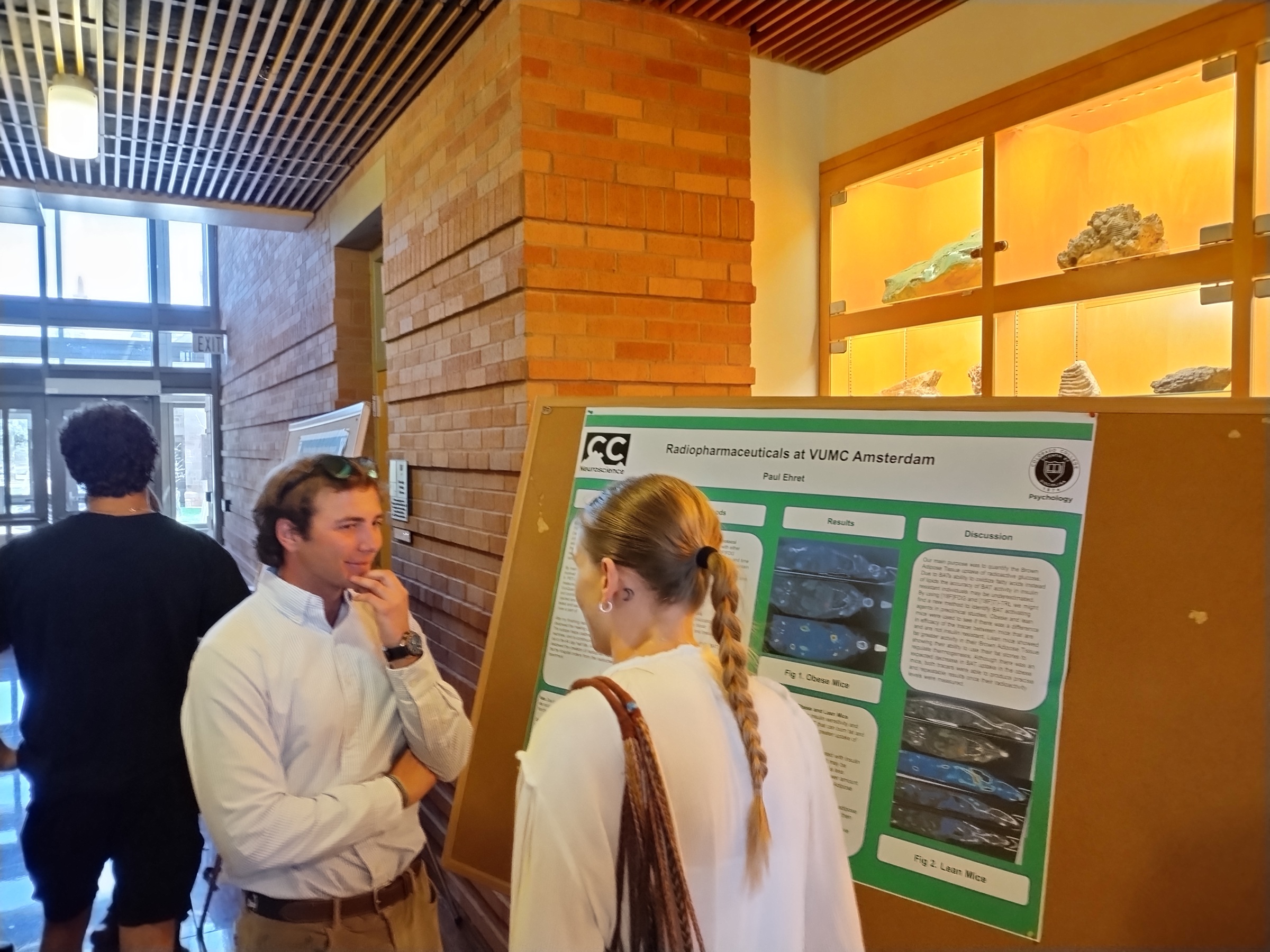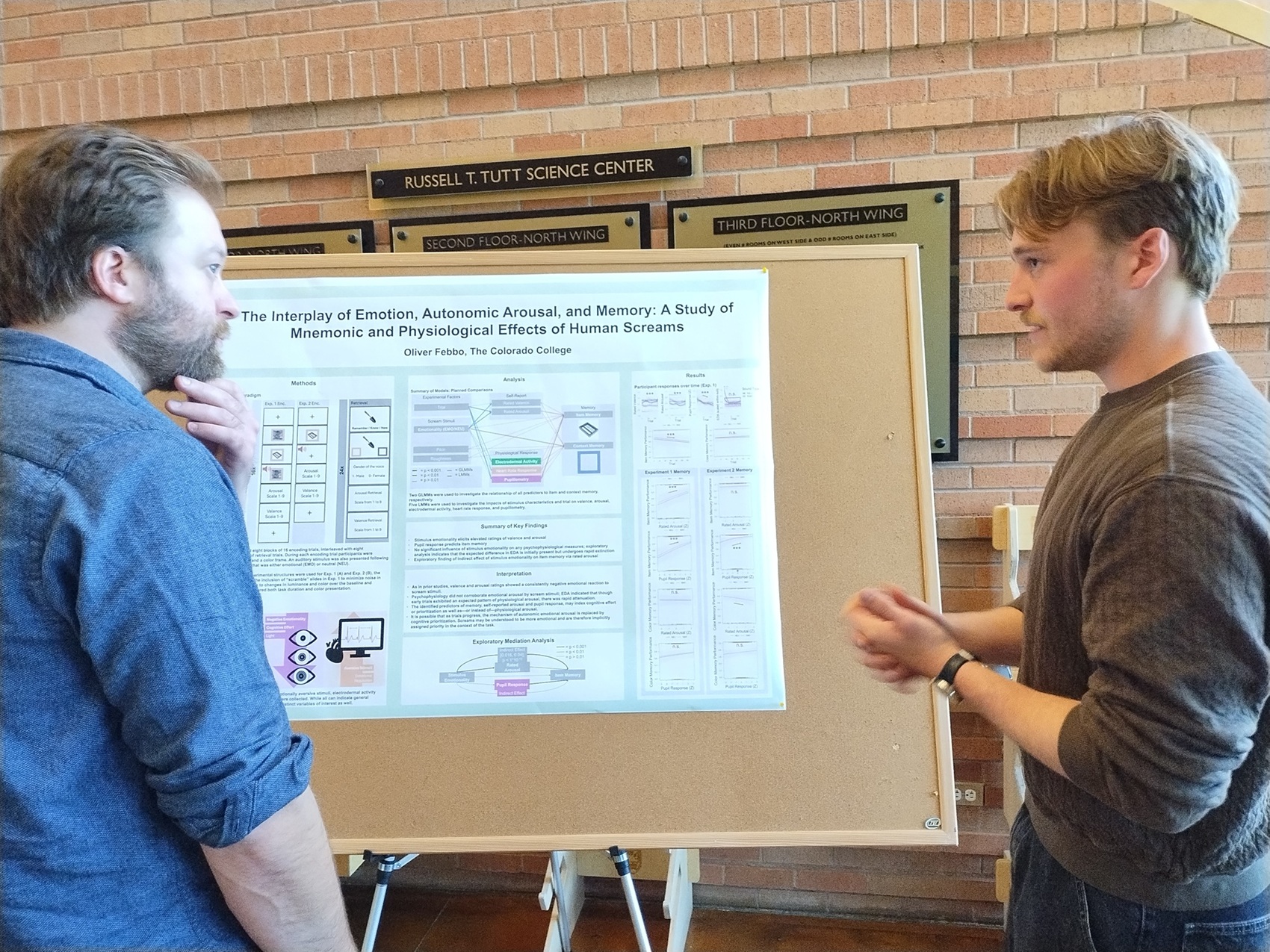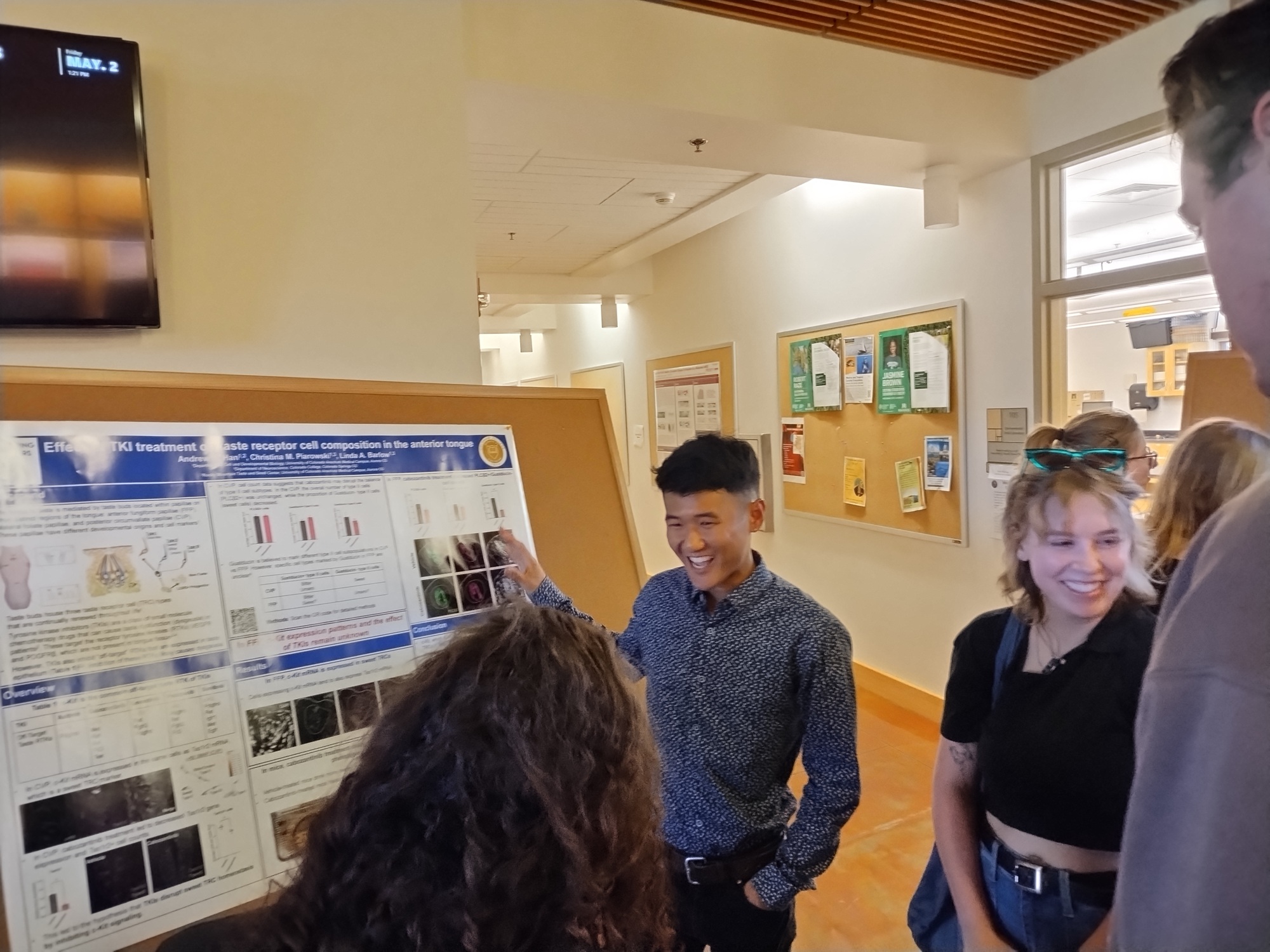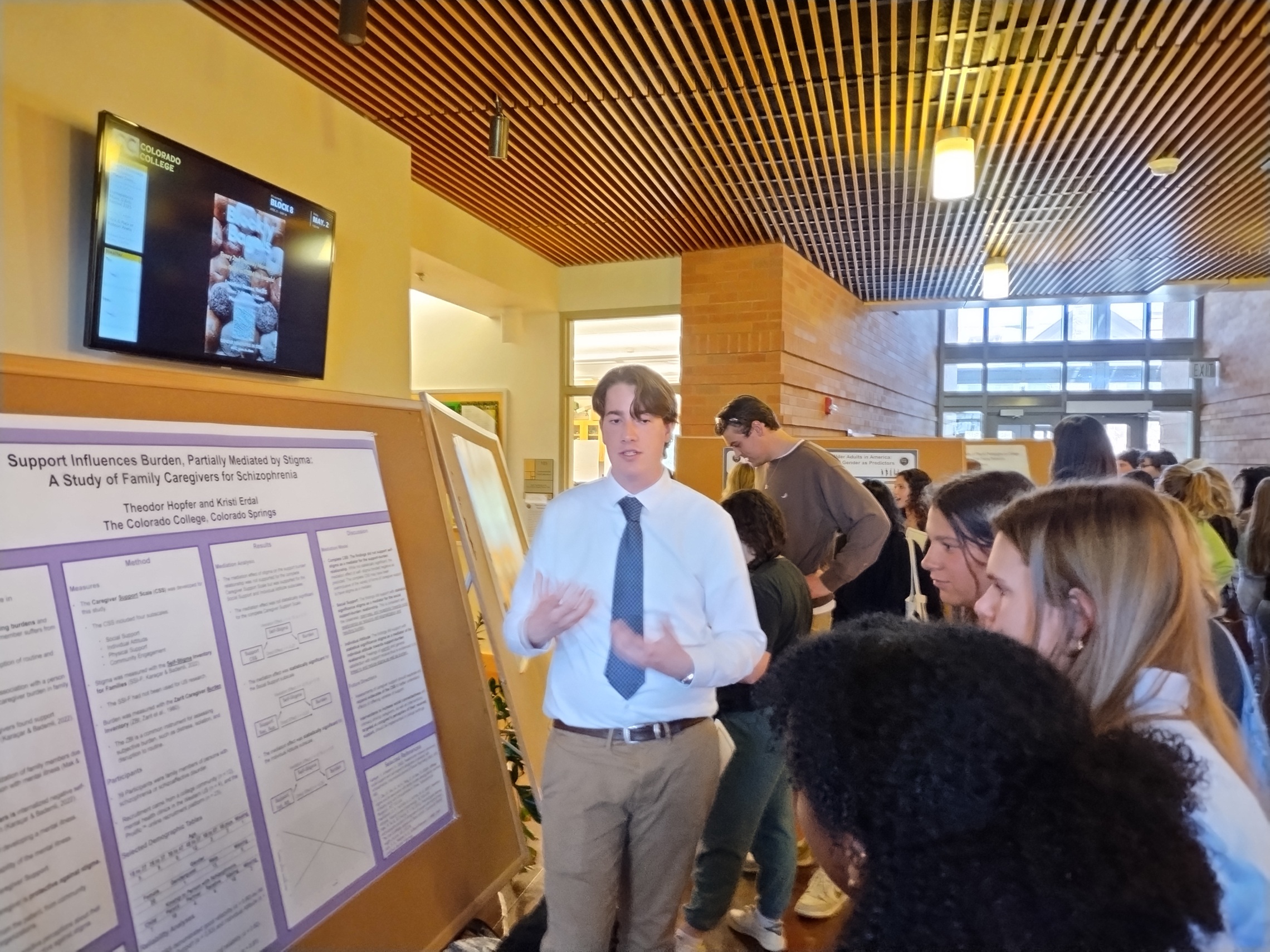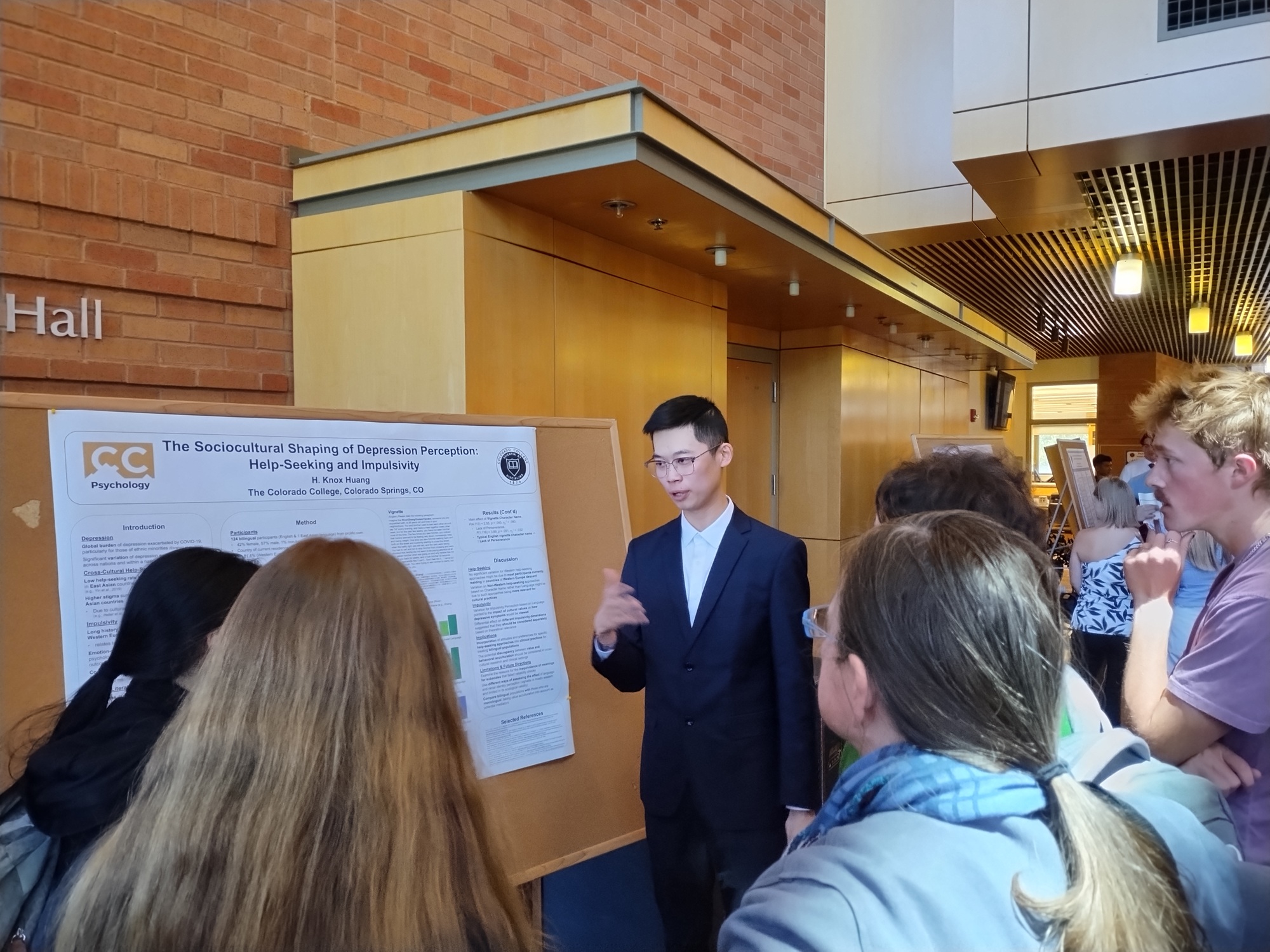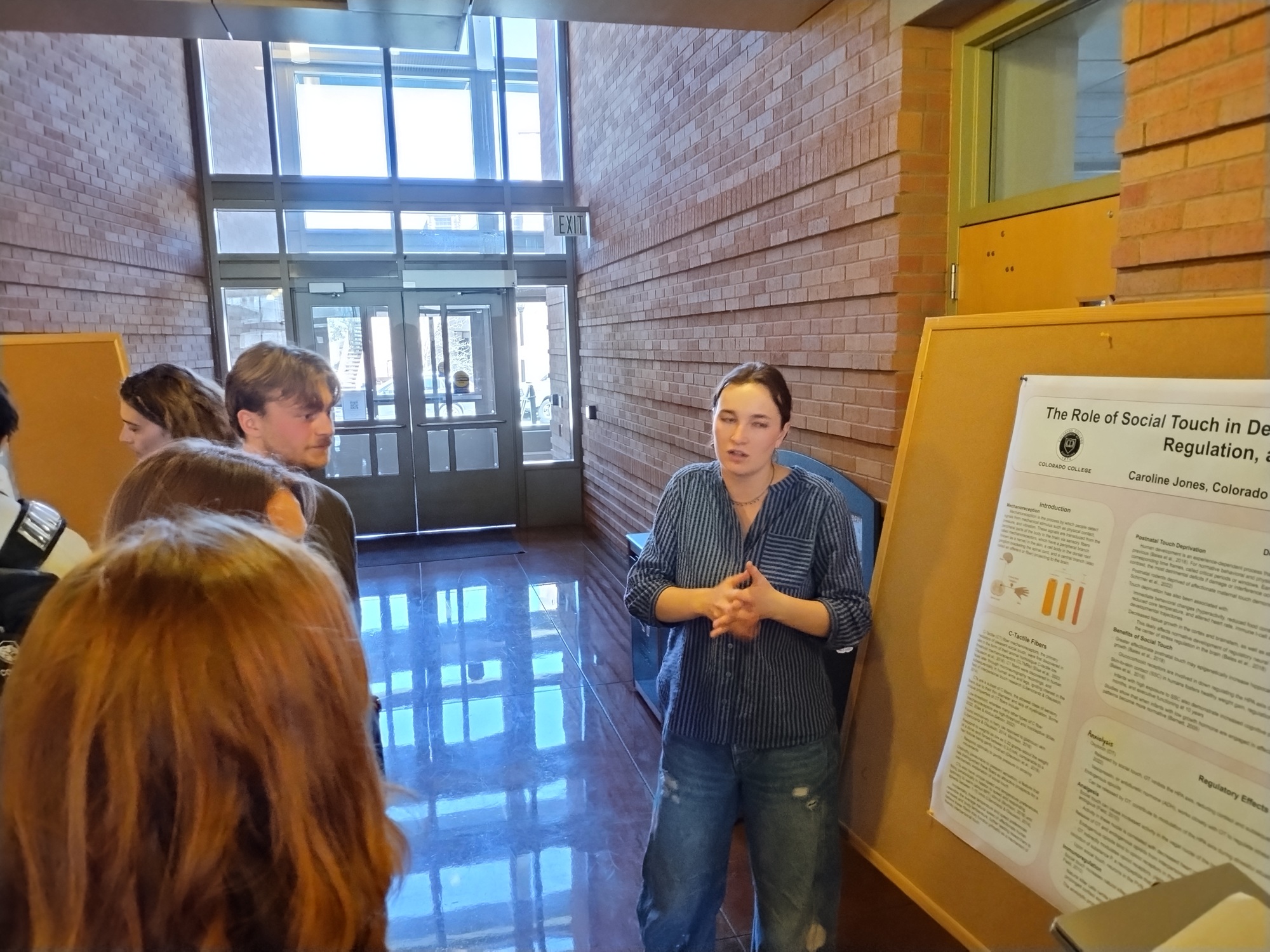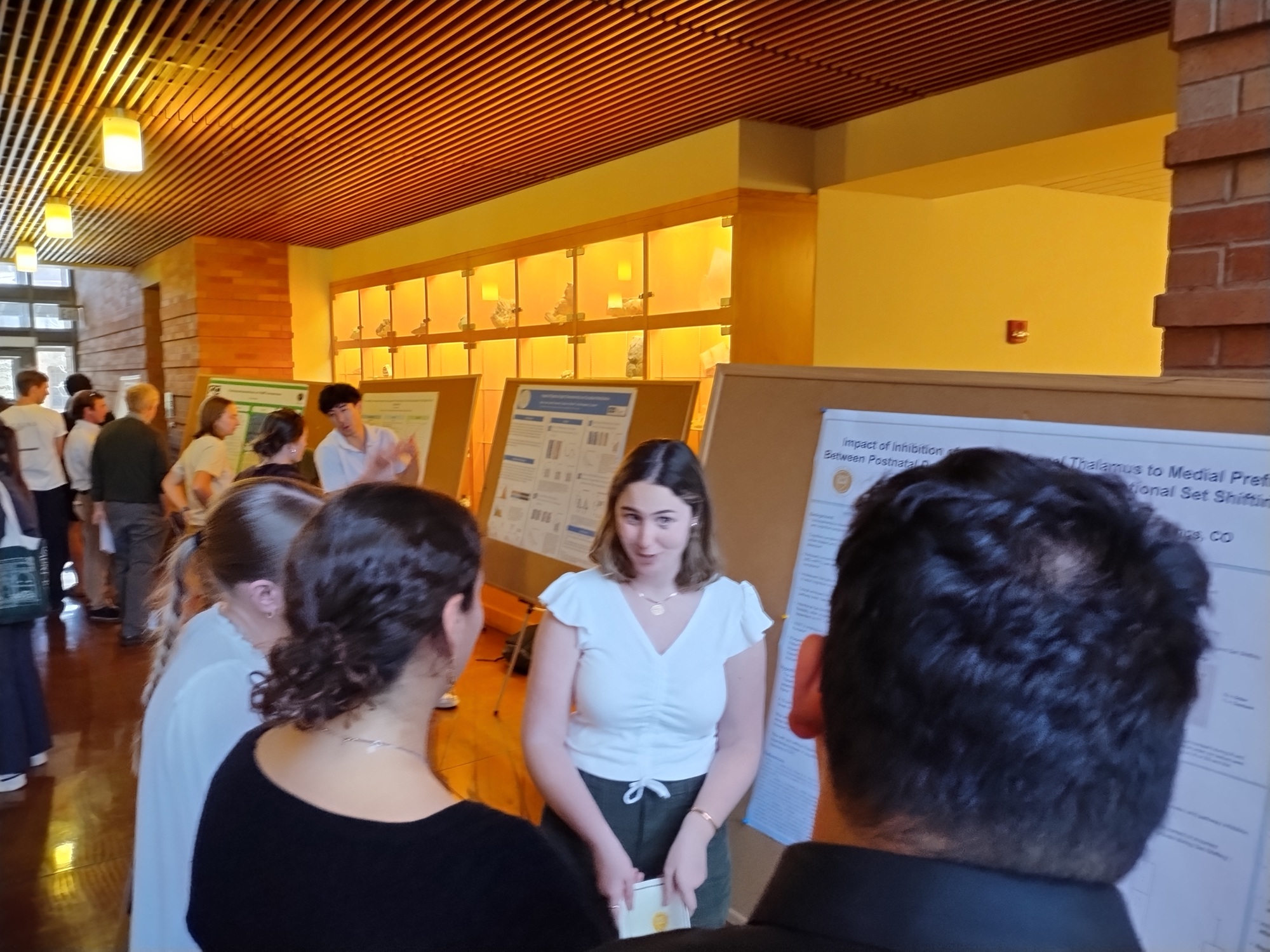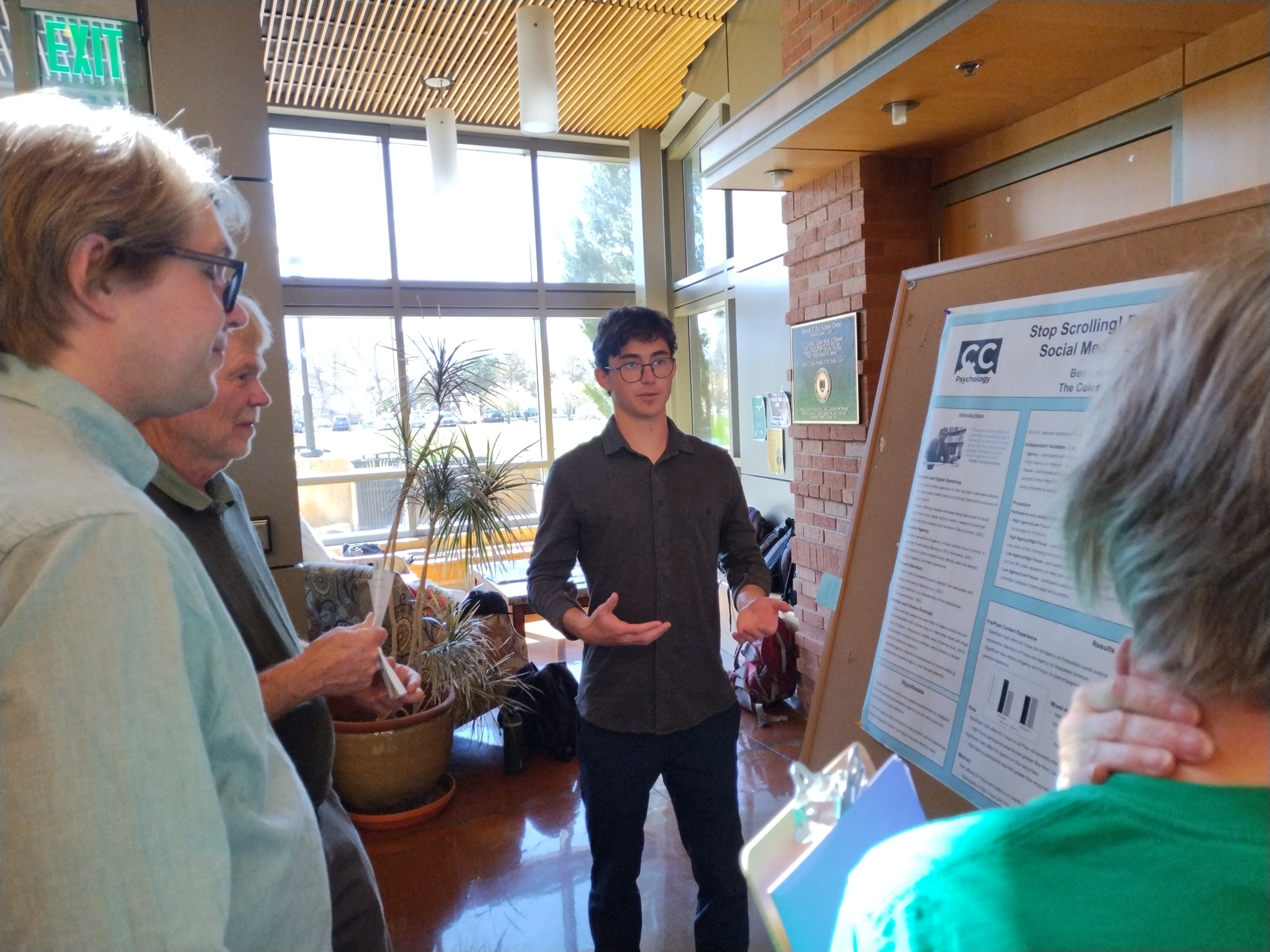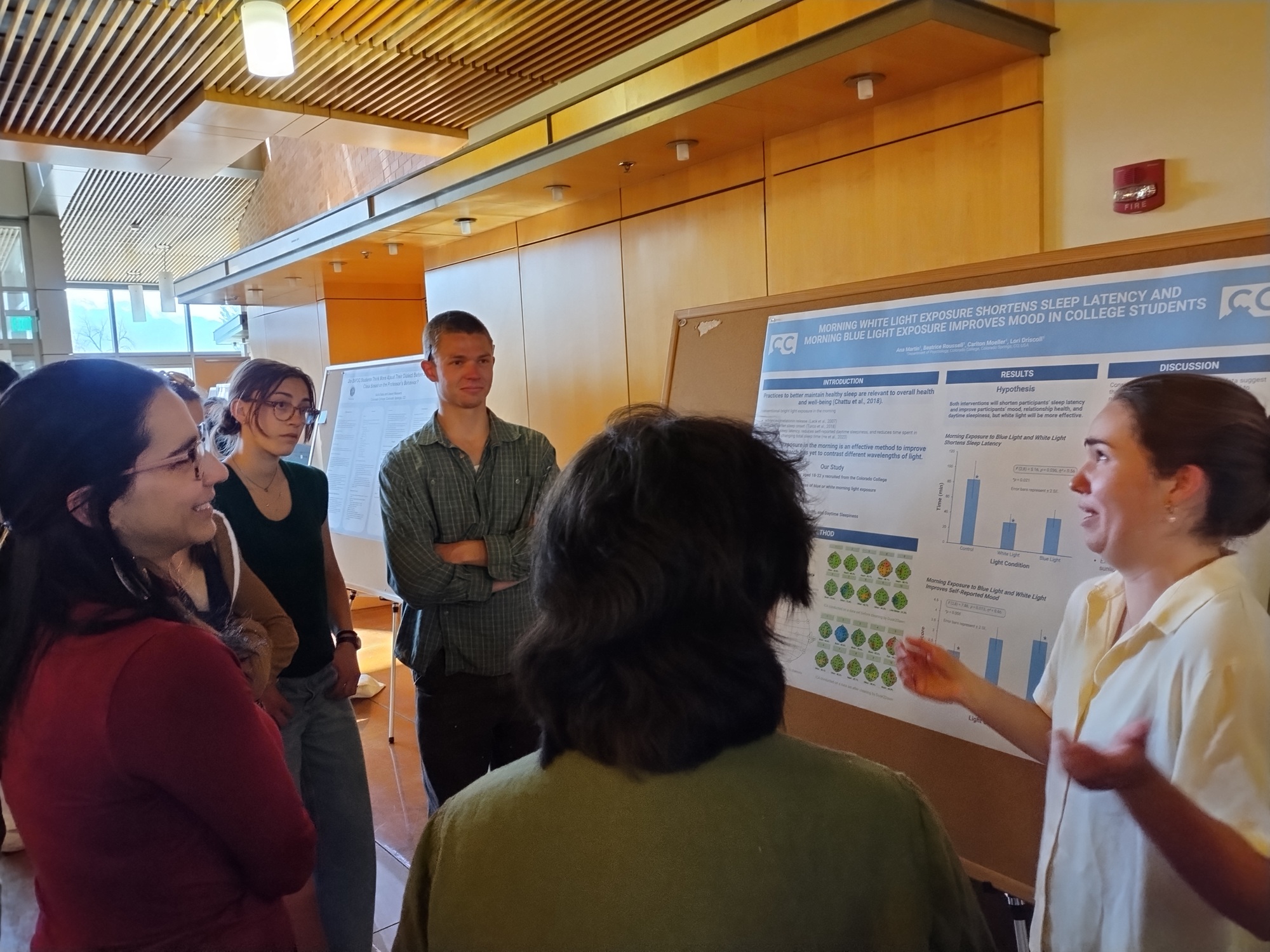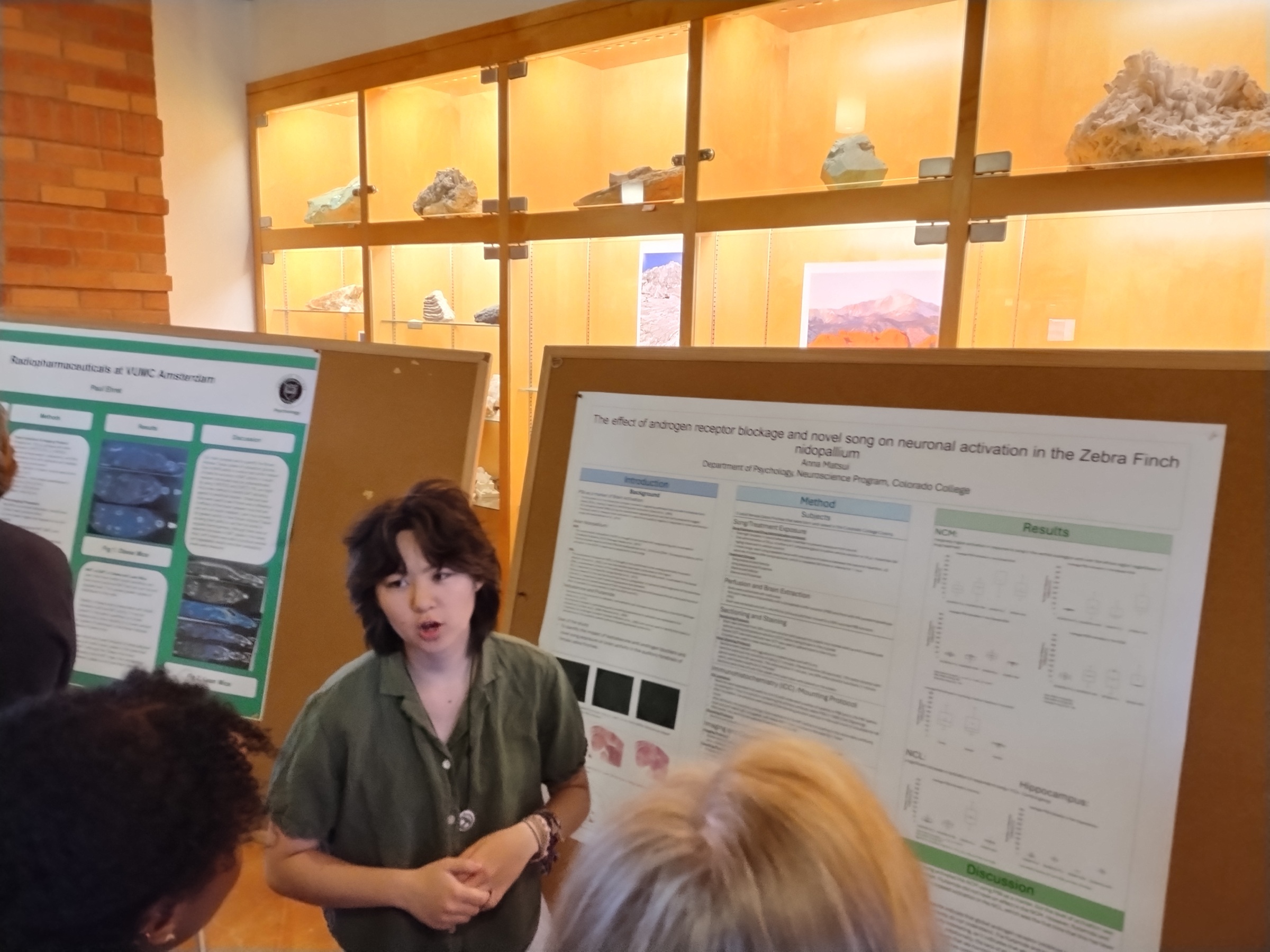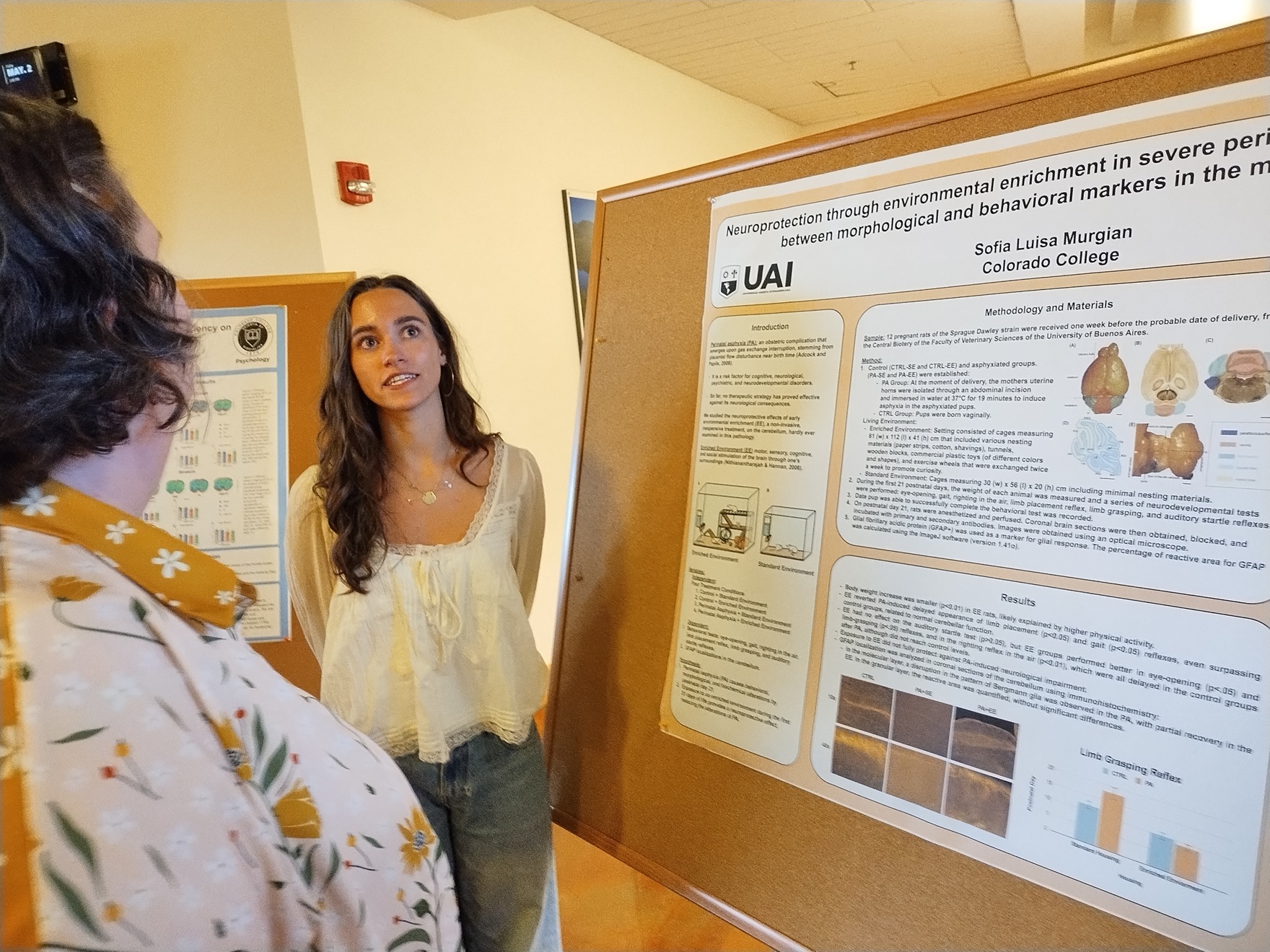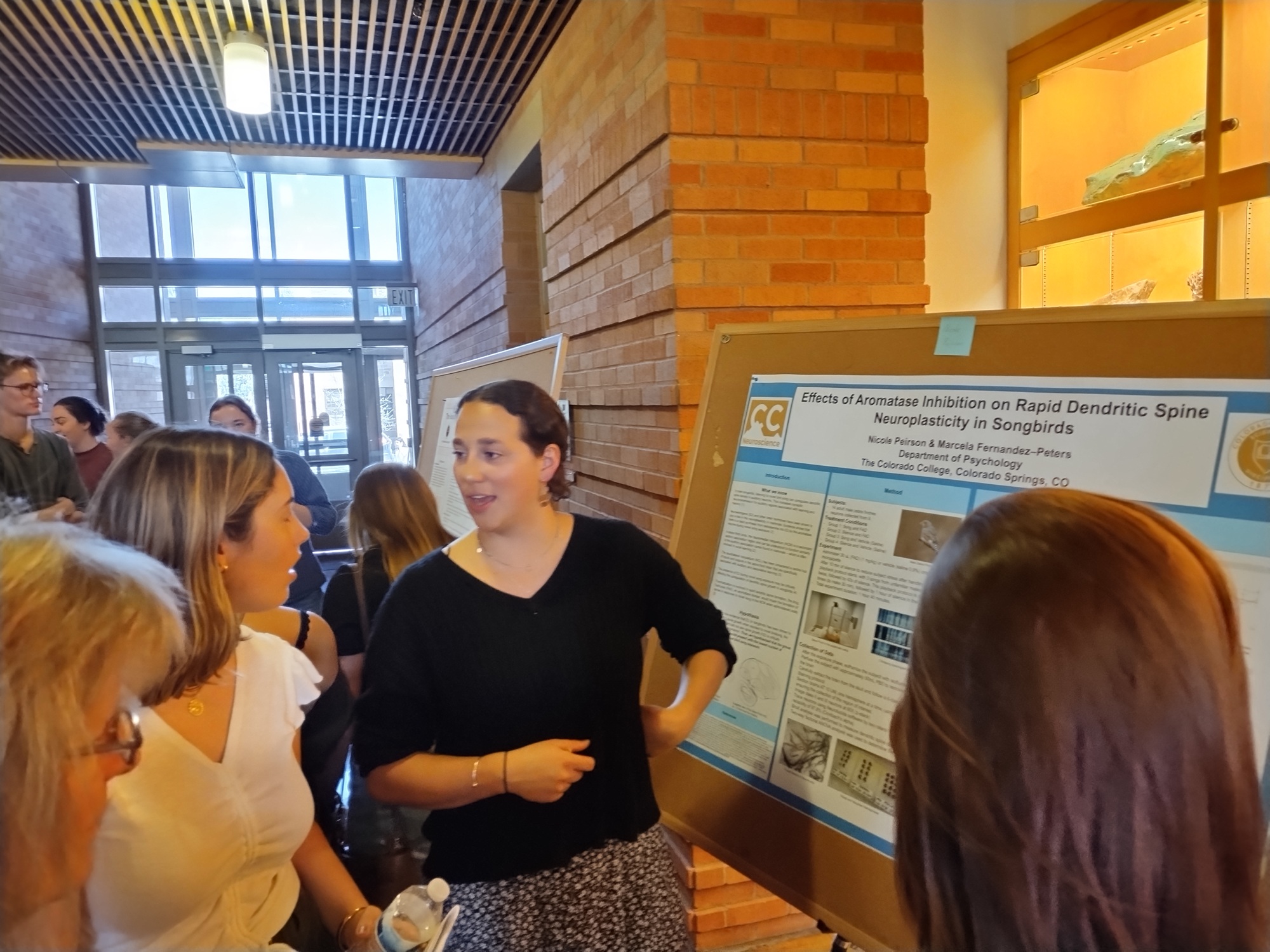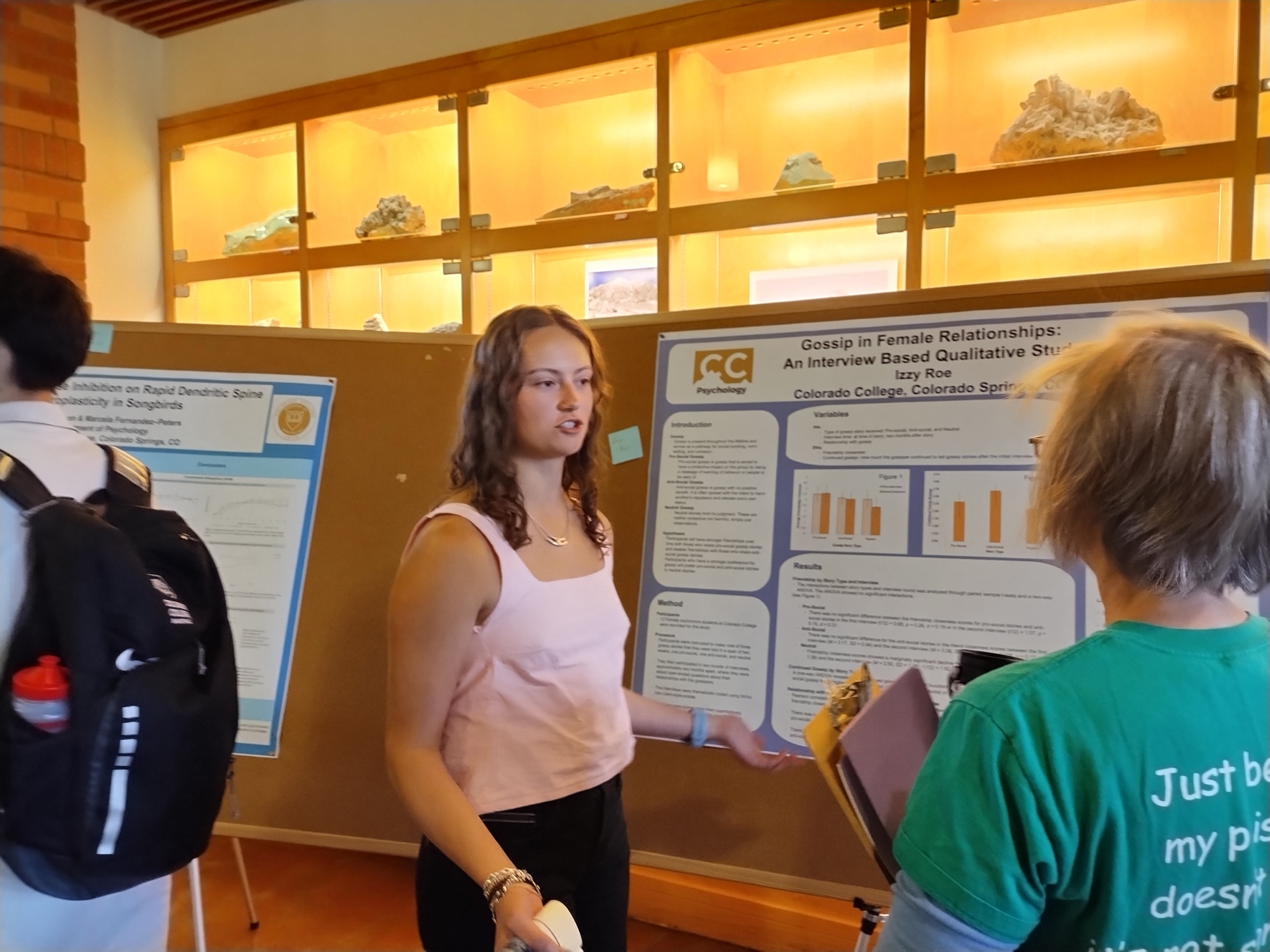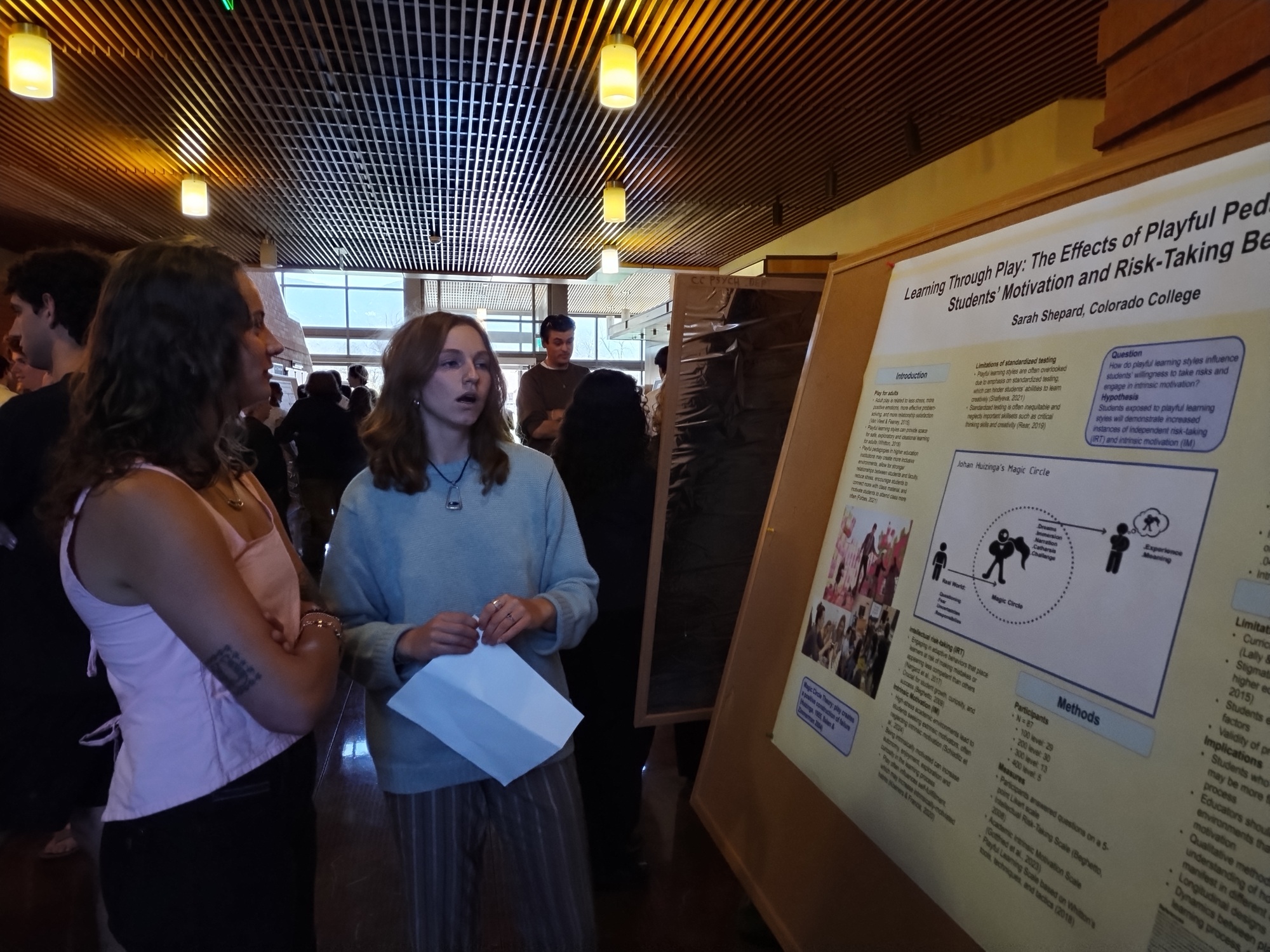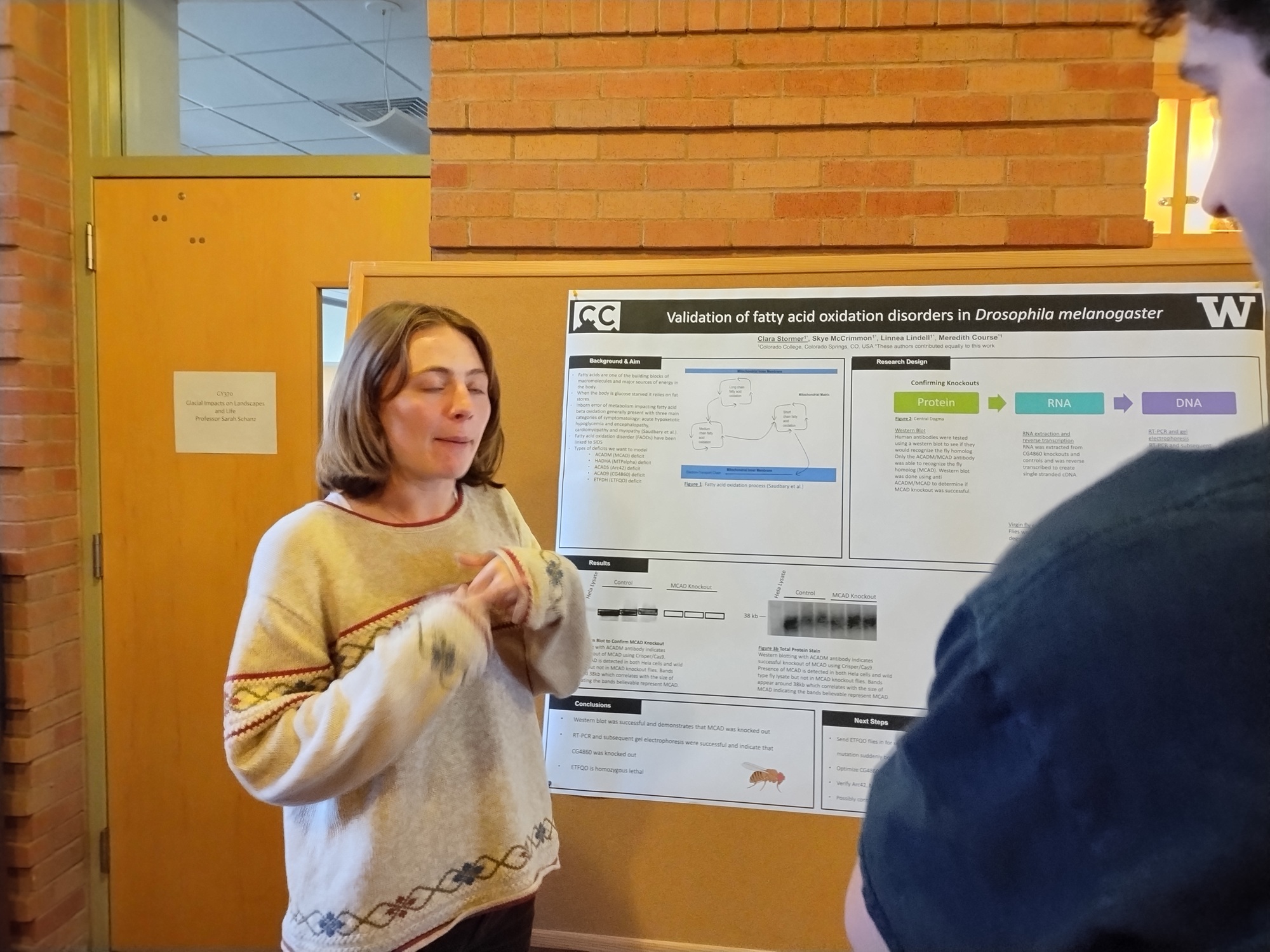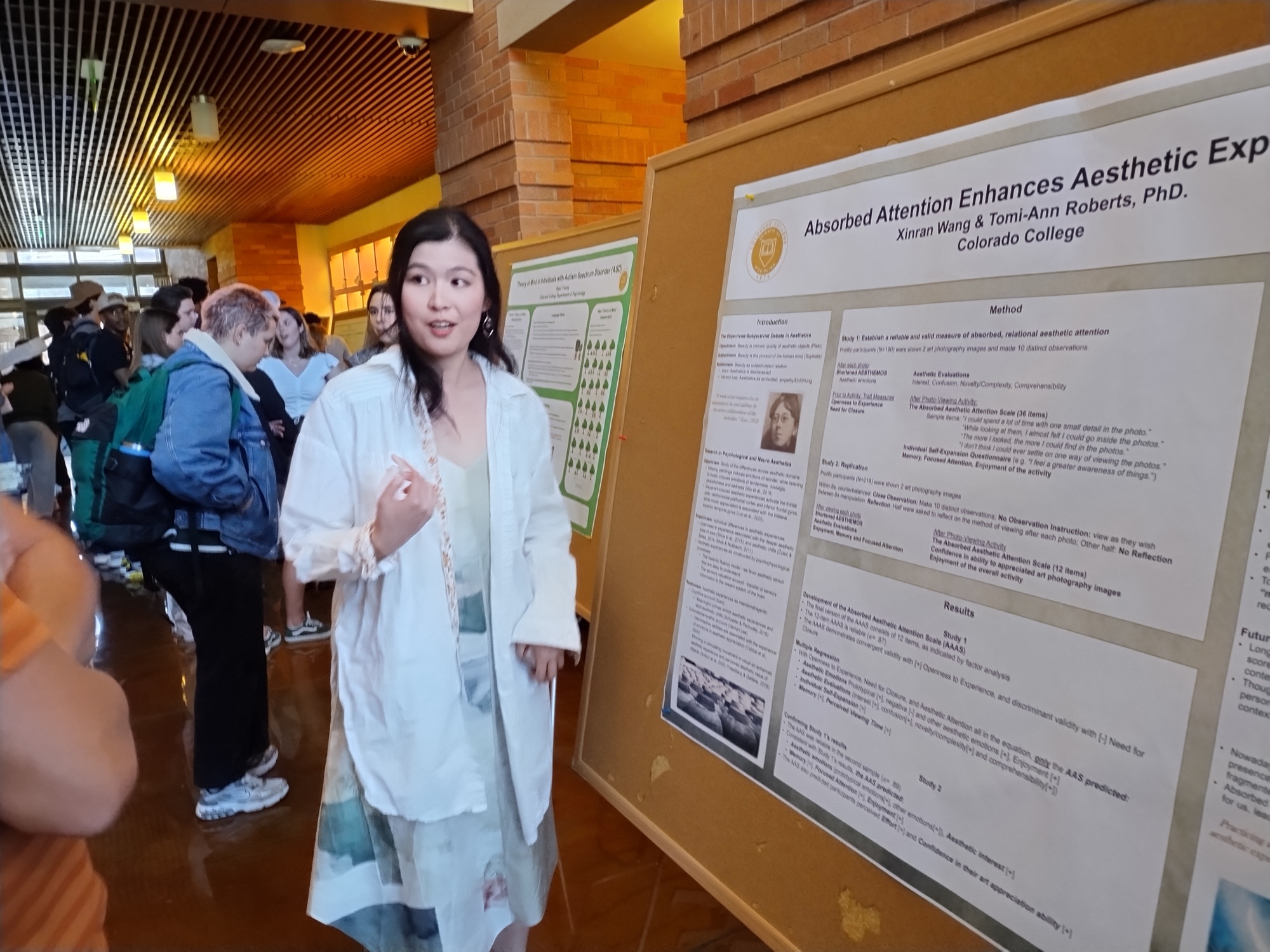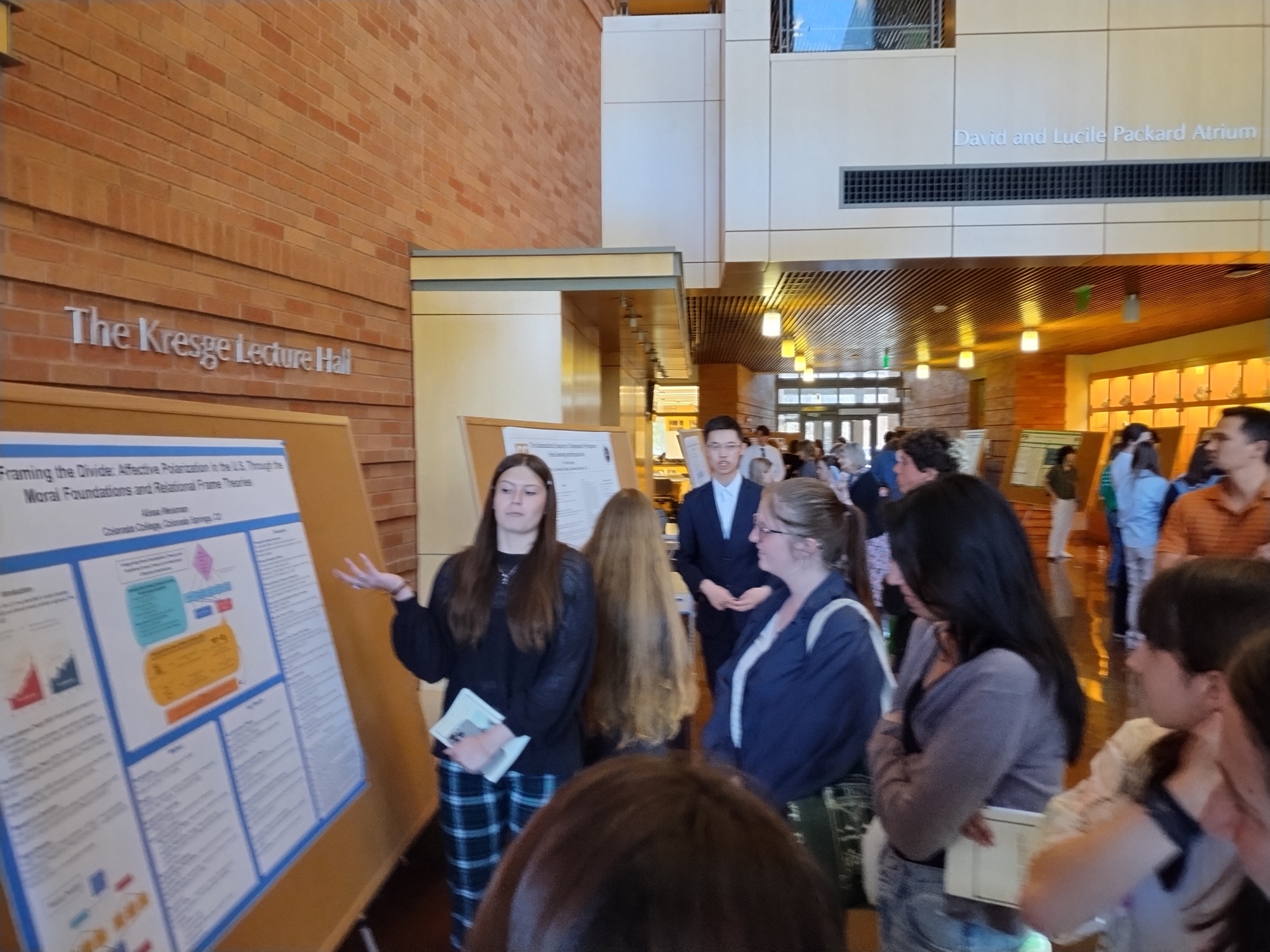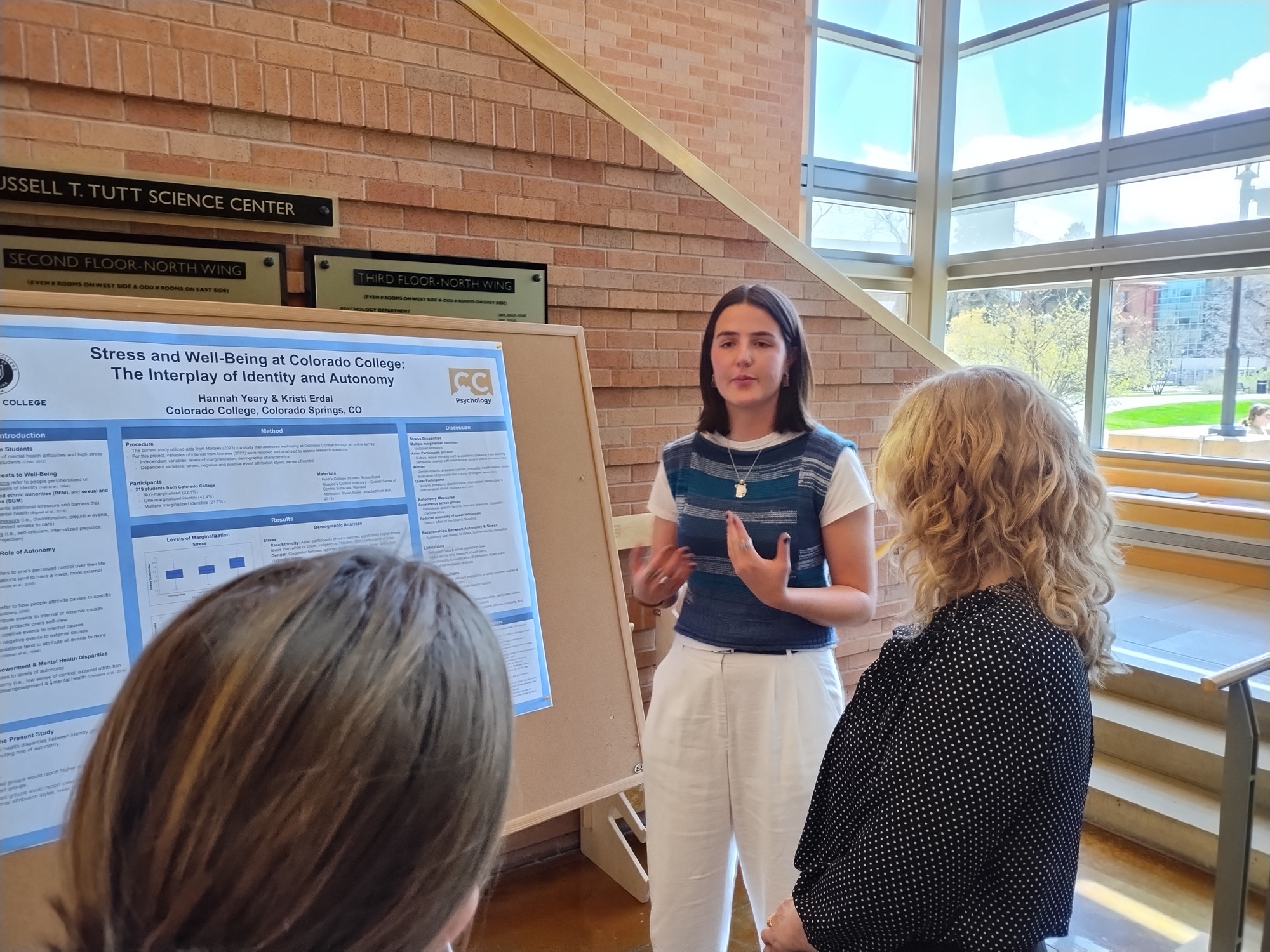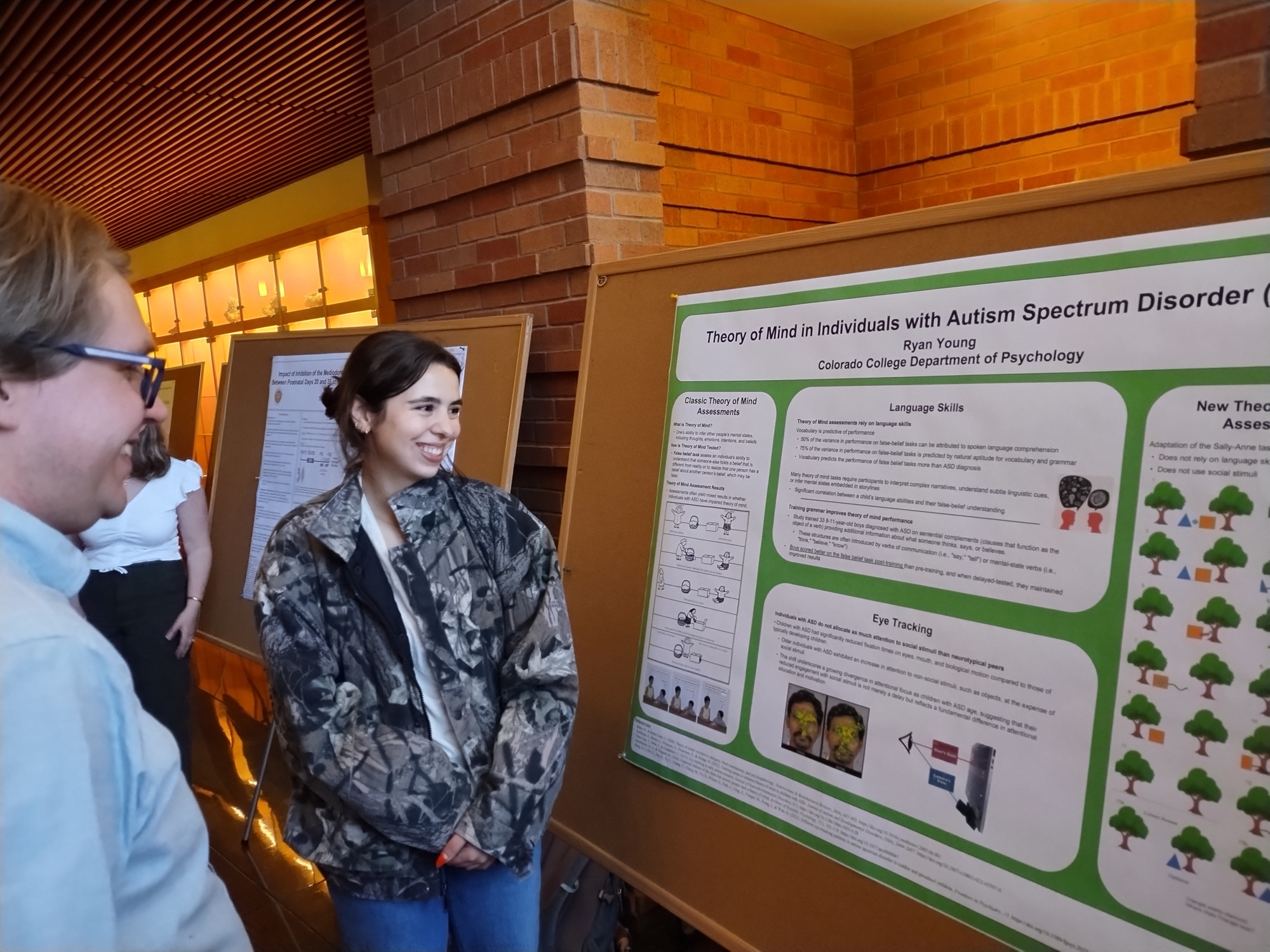Poster Day 2025
Neuroscience
Advisor: Lori Driscoll
Combined Effects of Prenatal Alcohol and Placental Insufficiency on Brain Microstructure in a Preclinical Model
Prenatal alcohol exposure (PAE) and placental insufficiency (PI) are known to adversely affect fetal brain development, yet the combined impact of these insults remains poorly understood. This study aimed to investigate the structural brain changes associated with PAE, PI, and the combined effect of PAE and PI in a rodent model. Pregnant Long-Evans rats were exposed to moderate voluntary alcohol consumption (5% ethanol) throughout gestation. On embryonic day 19, PI was induced via transient clamping of the uterine arteries to some of the rodent models. Offspring were delivered normally and evaluated at postnatal day 35 using ex vivo magnetic resonance imaging (MRI) to acquire diffusion tensor imaging (DTI) to assess brain microstructure in the medial prefrontal cortex (mPFC) and striatum. Fractional anisotropy (FA), Mean diffusivity (MD), axial diffusivity and radial diffusivity were used and analyzed across four groups: Sham. PAE, PI and combined PAE and PI. Results revealed significant alterations in blood flow in the MPFC and the striatum. The Striatum demonstrated greater vulnerability, with all parameters significantly disrupted. These findings highlight the differing effects of PAE and PI on developing brain regions, emphasizing the striatum’s heightened sensitivity to prenatal insults. This model provides a platform for further exploration of mechanisms underlying neurodevelopment disorders and ability to assess cognitive function related to these critical brain regions.
Psychology
Advisor: Tricia Waters
Navigating the Pressure: The Role of Academic Stress and Parental Expectations in Shaping Psychological Distress Among Indian College Students
Academic stress and parental expectations significantly contribute to psychological distress among Indian college students. In the Indian sociocultural context, academic success is closely tied to familial honor, social mobility, and financial stability, increasing performance pressures. This study examines how perceived academic stress and parental expectations affect depressive symptoms and cognitive-emotional impairments, focusing on academic stress as a mediator. Data was collected from 56 college students aged 18 to 26 currently enrolled in Indian higher education institutions. Measures of academic stress, parental expectations, depressive symptoms, and self-stigma were assessed. Results show that both academic stress and parental expectations are positively correlated with depressive symptoms, with academic stress mediating the relationship between familial expectations and psychological distress. Self-stigma further hinders mental health help-seeking. These findings highlight the need for culturally sensitive interventions that address academic pressure, familial expectations, and stigma, aiming to enhance student well-being and promote resilience in the Indian educational context.
Neuroscience
Advisor: Erin Murphy
The Effect of Banded Hip Mobilization on Squat Kinematics in College Students
PURPOSE
The purpose of this study was to investigate the effects of banded posterior femoral glide and banded lateral distraction on sagittal and frontal plane squat kinematics in college students, specifically focusing on lower extremity angles of the hip, knee, and ankle joints during the deepest aspect of a squat
METHODS
A total of 24 college students (n=7 female) participated in this study. Each participant performed squats before and after undergoing banded hip mobilization techniques comprised of a posterior femoral glide and lateral distraction. Squat kinematics were assessed by measuring knee, hip, and ankle flexion angles from the sagittal plane using Dartfish motion capture system. Leg alignment was assessed from the frontal plane by taking valgus and varus measures using the same technology. Data were analyzed using a Two Sample Paired t-Test for Means to determine the significance of changes in sagittal and frontal plane kinematics pre- and post-mobilization.
RESULTS
The results indicated a significant increase in hip (M=59.73°, SD=9.09° to M=56.10°,SD=11.04°; P=0.0250) and knee flexion (72.00°, SD=15.64° to 65.38°, SD=°; P=0.0014) and a decrease in ankle flexion (79.27°, SD=6.48° to 82.77°, SD=6.44°; P=0.0036) post-mobilization.
No significant differences were observed in knee valgus/varus measures in either leg pre- and post-mobilization( frontal plane kinematics).
CONCLUSION
The findings of this study suggest that banded hip mobilization techniques can effectively increase and knee flexion while decreasing ankle flexion during squats. These changes suggest a shift in the movement pattern while squatting which may are consistent with safer squat mechanics. These results have implications for rehabilitation and performance enhancement strategies aimed at mitigating injury risk in college students.
Neuroscience
Advisor: Lori Driscoll
Examining Astrocyte Morphology in Alzheimer’s Disease with Antibodies MT3, ETNPPl, and SLC1A2
Astrocytes play a vital but understudied role in the development, prevention, and treatment of Alzheimer’s Disease (AD). The amyloid-beta plaques characteristic of AD spatially colocalize with activated microglia and astrocytes, and reactive astrogliosis precedes plaque formation. Astrocytic role is emphasized by the predominant expression of AD risk genes in glial cells. In this project, antibodies MT3, SLC1A2, and ETNPPL are used to visualize astrocyte morphology and quantify colocalization and signal intensity. MT3 stains the astrocyte cell body, SLC1A2 stains the astrocytic cell membrane, and ETNPPL stains the astrocytic nuclei. Previous research indicates downregulation of SLC1A2 and MT3 in AD tissue. This project utilized multiplex immunofluorescence staining for visualization and Fiji ImageJ software for quantification. Results showed downregulation of ETNPPL and SLC1A2 in all layers of frontal cortex AD tissue in comparison with Healthy Control tissue. This research is applicable to potential AD pharmaceutical treatment targets and to identify root causes of AD pathology. Research was performed in collaboration with Karolinska Institutet and the Human Protein Atlas Project under the supervision of Dr. Jan Mulder and Dr. Nicholas Mitsios.
Psychology
Advisor: Kristi Erdal
Perceived Experience of Ageism in Older Adults in America: Investigating Culture of Origin, Age, and Gender as Predictors
Older adults are frequently the target of age-based prejudice, with approximately 93% of American older adults between 50 and 80 years of age experiencing ageism in the United States. Existing literature defines ageism as an insidious form of discrimination rooted in inaccurate beliefs, attitudes, and judgments based on age with both positive and negative manifestations. The established harmful impact of ageism on older adults underscores the need to examine factors that shape the experience of aging, such as culture of origin and gender. While previous research suggests that ageism intersects with these factors, findings have been mixed. This study explores how culture of origin and gender influence perceived age discrimination by comparing Chinese-speaking Chinese-American older adults with English-speaking White/Caucasian older adults. Participants completed the Older Adult Experiences (OAE) scale and provided relevant demographic information. It was hypothesized that English-speaking White/Caucasian participants would report more perceived age discrimination experienced compared to Chinese-speaking Chinese-American participants, which was supported. It was also hypothesized that female participants would report more negative perceived age discrimination experienced compared to male participants, but no significant gender differences emerged. Across groups, it was expected that participants would report more perceived age discrimination experienced associated with negative stereotypes than with positive stereotypes. However, results showed the opposite trend, with negative items rated lower and positive items rated higher. This suggests that older adults may hold relatively positive views of aging, aligning with the “paradox of aging” phenomenon. Study limitations and considerations for future research are discussed.
Psychology
Advisor: Tricia Waters, Korrie Sparks
Building Resilience in Children with Developmental Disabilities Through Occupational Therapy
The present directed field study was informed by observations from occupational therapy sessions with children exhibiting a wide variety of developmental disorders and delays, supporting the argument that occupational therapy is a holistic and effective way to build resilience in children who struggle with sensorimotor delays, emotional regulation, and executive functioning. Occupational therapy is an intervention that addresses the whole child––physical, sensorimotor, cognitive, emotional, and psychosocial domains––to improve daily living and adaptive functioning. The literature reviewed supports the notion that occupational therapy can be an effective intervention for improving motor, sensory and visual abilities, increasing participation in activities of daily living. More empirical research ought to be done to strengthen the current body of research. This field study focused on two children with autism spectrum disorder and co-occurring developmental delays who demonstrated qualitative improvements across various developmental domains throughout the duration of treatment. Occupational therapy helps build resilience in children with developmental disabilities who are more likely to become easily frustrated, use maladaptive coping strategies, and show less persistence in the face of challenges by building necessary skills and improving self-confidence.
Neuroscience
Advisor: Ryan Maloney
Exploring Behavioral Individuality under Serotonin Manipulation in Drosophila melanogaster
Adaptive behavioral variability allows organisms to strengthen survival in unpredictable environments. The common fruit fly, Drosophila melanogaster, serves as an ideal model to examine the individual differences as they exhibit both behavioral drift and bet-hedging strategies, allowing populations to maintain flexibility while ensuring survival across changing conditions. Modulating specific serotonin receptors has been seen to affect behavioral variability in both phototactic and locomotor preferences. This study investigated the effects of knocking out specific genes encoding each of the five serotonin receptors in Drosophila (5HT1A, 5HT2A, 5HT1B, 5HT2B, and 5HT7) and comparing them to an isogenic control group (Iso-D-1). The effects were measured via analyzing turning bias using a Y-maze assay with the MARGO automated tracking software. Individual flies were tracked for two hours over three days to assess differences in turning bias consistency. Flies with the 5HT1A receptor knockout exhibited the most statistically significant deviation from the control group with their turning biases reducing in stability (p<0.001), supporting the role of serotonin in maintaining consistent locomotor behavior. These results reinforce the idea that serotonin plays a role in balancing behavioral consistency and flexibility, contributing to bet hedging strategies and individual locomotor patterns across multiple days.
Psychology
Advisor: Tricia Waters
Breaking Down Barriers: The Impacts of Adaptive Sports for Individuals with Autism Spectrum Disorder
Adaptive sports and physical activity for individuals with Autism Spectrum Disorder (ASD) has been explored through a variety of activities, but it is not as commonly seen as other therapies like Applied Behavior Analysis and Occupational Therapy. Common deficits of Autism Spectrum Disorder such as persistent impairments to social interactions and hypersensitivity to sensory stimulations are examined as well as how they impair daily life and participation in physical activity. This review critically examines the current literature surrounding the impacts on individuals with Autism that come as a result from participating in adaptive sports and physical activities. According to existing research, impacts to social and motor skills are examined as well as positive impacts to an individual’s physical health. Quality of life measures and the sense of community, belongingness, and purpose that an individual experiences are additionally studied. Benefits towards socialization and quality of life further impact an individual’s outlook on life and having a sense of community provides greater opportunities for social inclusion and activity accessibility. The benefits found from the implementation of adaptive sports strongly emphasize how different forms of therapies can be utilized to aid people diagnosed with ASD. Limitations to research are further explored by unpacking barriers that individuals face in engaging in adaptive sports. Finally, this review intends to acknowledge the greater implications of present literature as well as where research in the field can grow in the future.
Neuroscience
Advisor: Lori Driscoll
Radiochemistry and Pharmaceuticals at VUMC Amsterdam
My time at VUMC Amsterdam was characterized by a large project testing the efficacy of different radiotracers DG and [18F]FDG on lean and obese mice. These mice were treated with saline and CL3. CL causes less weight gain in obese mice by exciting BETA 3 adrenergic receptors which are crucial for activating fat stores in humans. Brown and white adipose tissue (BAT and WAT) were checked for their radioactivity to see how [18F]FDG is less active in brown adipose tissue than white adipose tissue, affecting insulin resistance in the mice. After conducting the experiment I was tasked with measuring the radioactivity of all the mice. After the conclusion of the experiment, I shadowed the making of radioactive Zirconium for other lab experiments, and the making of radiotracers used in their hospital.
Neuroscience
Advisor: Lori Driscoll1, Monika Riegel2, Ulrike Rimmele2
1 Colorado College
2 Centre Interfacutaire en Sciences Affectives Universite de Geneve
The Interplay of Emotion, Autonomic Arousal, and Memory: A Study of Mnemonic and Physiological Effects of Human Screams
Screams are emotionally salient alarm communications that signal imminent danger and evoke immediate, consequential behavioral responses. It is thought that the reaction to these signals is driven by the percept of roughness, which reliably elicits a negatively valenced, arousing emotional response. The present study investigates the dynamic between scream stimuli, emotional and physiological responses, and memory outcomes; an emotional memory paradigm leverages scream stimuli to elicit emotional arousal and observe effects on memory. Throughout the paradigm, emotional arousal is indexed by self-reports, electrodermal activity, heart rate, and pupil dilation. Analyses investigate hypothesized relationships between scream presentation, resulting alarm state, and memory. The findings demonstrate that while screams elicit participant ratings consonant with negative emotional arousal, physiological responses expected to correspond to autonomic arousal are not observed. Pupil dilation does predict memory for items, however this is independent of observed physiological and emotional arousal. The predictive power of pupil response may be more reflective of working memory engagement maintaining a mental image of memory stimuli. Exploratory analyses identified an indirect effect of stimulus emotionality on item memory via rated arousal, but this may be dependent on implicit prioritization of scream-associated stimuli rather than autonomic arousal. Taken together, observed relationships appear to correspond to discrete emotional and working memory effects, respectively, rather than supporting a unified understanding of emotion and memory.
Psychology
Advisor: Tricia Waters
Concrete Couch Field Placement: A Proposed Bidirectional Relationship Between Prosocial Behavior and Moral Identity Development
Adolescent civic engagement through community-based organizations (CBOs) has positive outcomes for the community and individual development. These include long-term prosocial behavior and moral identity development. Based on a field placement at Concrete Couch, a community-art-based nonprofit, this field study proposes a hypothetical positive feedback loop model between prosocial behavior and moral identity development. A discussion and review of empirical work in these areas is followed by a discussion of ways empirical evidence might be reframed and applied to this community-based setting. Further research is necessary to explore the possible bidirectional relationship between prosocial behavior and moral identity development and its impact on developmental outcomes for adolescents.
Neuroscience
Advisor: Christina M. Piarowski, Linda A. Barlow
Effect of Tyrosine Kinase Inhibitor Treatment on Taste Receptor Cell Composition in the Anterior Tongue
Taste dysfunction, or dysgeusia, is a common symptom reported by patients treated with the tyrosine kinase inhibitor (TKI) cancer drug class. These TKIs inhibit receptor tyrosine kinases (RTKs) and primarily target VEGFR and PDGFRβ, which are not present in tongue tissue, so the mechanism by which TKIs cause dysgeusia is not understood. Within taste tissue, c-Kit is identified as an off-target RTK common among anti-angiogenic TKIs for the treatment of metastatic renal cell carcinoma (mRCC). Here, we characterize the changes in proportions of type II taste receptor cells (TRCs) in fungiform papillae (FFP) in the anterior tongue. We find that c-Kit tends to be co-expressed in sweet-sensing TRCs in FFP. In vivo, we find TKI treatment in mice results in a sweet indiscriminate behavioral phenotype. These results suggest that TKI treatment causes dysgeusia by inhibiting c-Kit, which dysregulates type II cell homeostasis, leading to deficits in sweet, and potentially other, taste modalities.
Psychology
Advisor: Kristi Erdal
Burden, Stigma, and Support Among Family Caregivers of Persons with Schizophrenia
Family caregivers experience a significant burden related to caregiving responsibilities for patients with schizophrenia, who often rely on family for assistance navigating daily life. This study investigates support, self-stigma, and burden in caregivers of persons with schizophrenia. Self-stigma refers to the caregiver’s negative self-perceptions due to their affiliation to a person with schizophrenia. A questionnaire was completed by 39 family caregivers of persons with schizophrenia drawn from clinical, college, and online recruitment streams. Self-stigma was found as a mediator of the support-burden relationship for two measures of support: the measure of social support and the measure of self-perception of support received. The findings suggest that feelings of connectedness and satisfaction with support relate to lower self-stigma, and indirectly lower caregiver burden.
Psychology
Advisor: Kristi Erdal
The Sociocultural Shaping of Depression Perception: Help-Seeking and Impulsivity
Depression is a common mental disorder that affects approximately 3.8% of the population worldwide. Low treatment-seeking rates among ethnic minority groups might be due to sociocultural influences on their perception of depression and its treatment. The current study used vignettes of depressed patients to assess if language and patient’s name impacted participants’ help-seeking preferences and their perception of the patient’s impulsivity levels. Participants who were bilingual in English and one of Japanese, Korean, or Mandarin (N = 124) were recruited via an online platform. Overall, results showed that East Asian vignette character name led to higher endorsement of non-western help-seeking strategies (e.g., traditional medicine), and East Asian language vignette led to the depressed patient perceived to be more impulsive. Limitations included measurement variance issues for certain subscales (e.g., positive urgency) and ecological validity of vignette methodology. Findings suggested the importance of language and name in bilingual populations’ depression perception processes.
Neuroscience
Advisor: Lori Driscoll
The Role of Social Touch in Development, Physiological and Affective Regulation, and Western Society
Social touch is a powerful agent that guides early stages of development, physiological and affective regulatory processes, nonverbal communication, and social relationships in humans and non-human animals. In humans, engaging in interpersonal touch can have numerous beneficial effects, but can also be an aversive experience depending on social context. Recent empirical research regarding social touch has largely focused on tracing the pathway of C-Tactile (CT) afferents from skin to brain, fibers that are thought to underly the mechanisms of social touch transduction. While CT fibers play a critical role in processing interpersonal touch, an approach that focuses primarily on identifying a physiological pathway is likely motivated by the development of pharmaceutical therapies and neglects to consider the diverse array of other factors that influence how people interact with social touch. This paper reviews existing CT research, as well as research exploring the regulatory and signaling functions of social touch and its evolution in humans and non-human animals. The sociological, cultural, environmental, and cognitive factors that interplay with social touch are critically assessed, and systemic implications and future research directions are proposed.
Neuroscience
Advisor: Marcela Fernandez-Peters
Impact of Inhibition of the Mediodorsal Thalamus to Medial Prefrontal Cortex Pathway Between Postnatal Days 20 and 35 on Attentional Set Shifting
Schizophrenia is a serious neurophysiological disorder with poorly understood and under-researched cognitive symptoms. Recent research in mice has shown that dysregulation of the thalamocortical pathway during adolescence can lead to cognitive deficits in adulthood. This study aimed to address whether a 15-day window of inhibition from postnatal day P20-P35 would elicit cognitive deficits and decrease in cognitive flexibility in younger mice (70 days old). The thalamocortical pathways of Gbx2CreERT mice were inhibited on postnatal days 0-13 by delivering Dual Viral AAV injections carrying a Cre-dependent inhibitory designer receptor hM4D into the thalamus. These experimental group (hM4D) mice then received the DREADD ligand clozapine-n-oxide (CNO) via intraperitoneal injections twice a day from postnatal 20 -35 to hyperpolarized thalamic neurons. Cognitive deficits, specifically cognitive flexibility, were assessed through attentional set-shifting tasks (ASST) on P70. Results showed no significant impairments in the number of trials to reach criterion or correct choice frequency in ASST between hM4D and control mice. Our findings suggest that a 15-day period of inhibition from P20-35 may have been premature in terms of thalamocortical development, indicating the pathway develops later in adolescents. Identifying the critical developmental window could inform potential preventative treatments for cognitive symptoms of schizophrenia in the future.
Neuroscience
Advisor: Ryan Maloney
The Function of Serotonergic Receptors in Mediating Drift in Isogenic Drosophila Populations
Like many organisms, Drosophila melanogaster employs a combination of evolutionary strategies to diversify their phenotype and optimize survival in unpredictable environments. Among these strategies are bet hedging, where a subset of population deviates from the norm, and drift, which describes individual variability in phenotypic behavior over a lifespan. Prior work using pharmacological and genetic manipulation has shown that serotonergic neuromodulation regulates variability in numerous behavioral traits, such as phototactic preference and locomotion. Notably, knockdown of the 5-HT1A and 5-HT7 receptors has been linked to increased locomotive variability, suggesting their specific role in moderating motor-directed behaviors. This study analyzed the effects of all five serotonergic receptor knockouts in mediating drift in turning bias variability on an individual level, postulating a significant effect of the 5-HT1A and 5-HT7 receptors on locomotive behavior stability. Serotonergic mutant flies from the Bloomington Drosophila Stock Center were individually housed and tested in a Y-maze assay measuring turning bias and frequency over two-hour testing periods across three days. Each mutant strain was tested across three consecutive days per week to assess their turning bias stability over time. Null mutants in the 5-HT1A receptor showed an increase in drift compared to the control group (p ≤ 0.001). These findings implicate the role of the 5-HT1A receptor in modulating locomotive behavior in Drosophila across the individual lifespan and provide a foundation for future research into 5-HT1A neuromodulatory mechanisms regulating motor behaviors across species.
Neuroscience
Advisors: Cristina Ghiani, Christopher Colwell
Impact of Spectral Light Characteristics on Circadian Modulation
Previous reports suggest that exposure to blue light during the day may be more beneficial than other wavelengths for the maintenance of circadian rhythms in mice. Additional analysis revealed that these positive effects were mediated by the photopigment melanopsin, which is maximally sensitive to blue/green wavelengths of light. The current study aims to explore if C57BL/6 mice are more sensitive to daytime exposure of blue-enriched or red-enriched lighting at low intensity levels (10 lx). 2 groups (n=7) of 3-month-old mice were housed in light-controlled cabinets and exposed to either blue-enriched light or red-enriched light at a 10 lx intensity for 12 hours a day. Daily activity patterns were measured using running wheels. Responses to phase advances and delays of the light-dark (LD) cycle as well as negative masking behavior and light-induced phase delays were recorded. Current results suggest that insignificant differences were found between red and blue-enriched lighting groups for original and phase advance conditions. However, significant differences were discovered between groups during the 6-hour phase delay, aligning with earlier predictions about the increased sensitivity to bluer wavelengths of light. Additionally, there appears to be a trend towards blue-enriched light exerting a stronger masking effect than red-enriched light, despite lack of significance. These results suggest that perhaps pure red lighting (1000K) or an increased sample size is needed to indicate a more significant role of the spectral composition of light in circadian system modulation.
Psychology
Advisor: Tomi-Ann Roberts
Stop Scrolling! Focused Attention Improves Social Media Engagement Experiences
When engaging with social media interfaces like Instagram, people prefer to rapidly switch or scroll through large quantities of content, and predict this selection agency will yield more positive experiences. However, studies show such digital switching actually causes more negative experiences, including boredom, engaging with social media. We hypothesized that engaging focused attention brings more positive experiences with social media and that scrolling through endless content inhibits this. In this study, we examined peoples’ experiences viewing Instagram content under varying degrees of selection agency and focused attention. We found that participants had better experiences - less boredom, more interest and enjoyment, and better memory - when they employed high, versus low, focused attention, while their selection agency had little impact. Overall, our findings suggest that in a digital world of endless options, peoples’ selection agency paradoxically places them in a state of choice overload. Instead, stopping the scroll and paying focused attention to selected content makes for higher quality social media experiences, enabling people to feel in control as they navigate digital environments of infinite content. .
Psychology
Advisor: Greg Peters
Addressing the treatment gap: An Evolutionary Perspective on Addiction’s effect on Public Stigmatization of Substance Use Disorders
Stigma remains a critical factor in the widening treatment gap for substance use disorder (SUD), disincentivizing individuals from seeking and utilizing treatment, and contributing to the overdose epidemic. The Brain Disease Model of Addiction (BDMA) is the most widely accepted model of addiction, in part, because it is thought to reduce the stigma surrounding SUD’s. Researchers have raised concerns about if the BDMA is truly effective in destigmatizing addiction. To address the destigmatization of SUD’s, a survey was conducted to analyze the effect an Evolutionary Perspective on Addiction (EPA) and Brain Disease Model of Addiction (BDMA) have on public stigmatization of SUD’s. No major effects on stigma were observed between the EPA, BDMA, and a control group. This study suggests that although neither the EPA and BDMA had effects on public stigma, future research should focus on altering the presentation of information about the EPA and the BDMA, analyzing the relationship between the BDMA and perceptions of criminality, and studying the effect of an individual’s stigma toward SUD and their own drug consumption or relationship.
Neuroscience
Advisor: Lori Driscoll
Morning White Light Exposure Shortens Sleep Latency and Morning Blue Light Exposure Improves Mood in College Students
Sleep is a crucial aspect of maintaining our health and well-being. Sleep loss and insufficient sleep can cause short-term disturbances in mood and productivity, as well as impact long-term risk for mental illness, obesity, heart disease, and premature mortality. Previous findings suggest that bright light exposure in the morning may be one potential method of improving sleep, but no comparison between light containing different wavelengths has yet been made. This experiment investigated morning white light exposure and morning blue light exposure as potential methods of improving sleep. We assessed sleep latency, mood, relationship health, and daytime sleepiness as measures of improved sleep and its benefits in college students. We found that the white light intervention significantly reduced sleep latency and that the blue light intervention significantly improved self-reported mood. Given our research question, we were unable to determine whether one type of light intervention was more beneficial than the other. However, by connecting light exposure to improvements in mood and sleep, our study supports morning light exposure as a potential non-pharmacological solution for maintaining sleep hygiene.
Neuroscience
Advisor: Marcela Fernandez-Peters
The Effect of Flutamide and Novel Song Exposure on PS6 activation in the Female Zebra Finch Nidopallium
Auditory neuroscience has been studied using zebra finches for their complex auditory system involved in vocal learning. One brain region, the caudomedial nidopallium (NCL), has been extensively studied in male zebra finches for its role in song learning and auditory memory. Many studies have examined the impact of novel song exposure and estradiol (E2) in the male zebra finch auditory nidopallium. However, the role of E2’s precursor molecule, testosterone, and its target, androgen receptors, in the zebra finch auditory system have not been studied in males or females. In addition, the caudolateral nidopallium (NCL) region has not been studied well in songbirds and the current literature indicates a high level of connectivity between the NCM and NCL, so this study aims to examine the impact of novel song and flutamide, an androgen receptor blocker, by looking at PS6 activation to identify any sexual dimorphisms in the nidopallium of female zebra finches. It was hypothesized that if androgen receptor activity is involved in song-driven auditory activation in the nidopallium, then flutamide administration would decrease activation. Data was collected by orally administrating either flutamide or vehicle to a female zebra finch and then exposing it to either silence or a novel song exposure protocol. Then, the bird was euthanized and perfused. The brain was then sectioned, and PS6-positive cells were stained using immunohistochemistry in the brain slices. PS6 was used as a molecular marker of brain activation because it is phosphorylated when neurons are active. The sections were imaged in a fluorescent microscope and then counted in three subregions of the NCM and NCL using FIJI software. This study found a significant main effect of song in PS6 expression in the ventral NCM, which aligns with existing literature and suggests that androgen receptors are not involved in the song-related processes in the NCM in female zebra finches. Additionally, this study found that novel song-induced PS6 activation in the NCL when combined with flutamide. The increased activation was not expected but may be due to a flutamide-induced increase in local testosterone levels. Finally, this study found an effect of silence in the hippocampus. Overall, this study identifies a new avenue of research in song research in female zebra finches. These results indicate that the female auditory system responds differently to novel songs than male zebra finches and that the role of androgen receptors in the auditory system is sexually dimorphic.
Neuroscience
Advisor: Juan Pablo1
1 Centro de Altos Estudios en Ciencias Humanas y de la Salud, Universidad Abierta Interamericana
Neuroprotection through environmental enrichment in severe perinatal asphyxia: Correlation between morphological and behavioral markers in the murine cerebellum
During my time abroad I interned as a lab assistant at the Universidad Abierta Interamericana in Buenos Aires. I was lucky enough to work with graduate student Tamara Kobiec and her team researching the neuroprotective effects of environmental enrichments on perinatal asphyxia. Perinatal asphyxia (PA) is an obstetric complication that emerges upon gas exchange interruption, stemming from placental flow disturbance near birth time. It is a risk factor for cognitive, neurological, psychiatric, and neurodevelopmental disorders. So far, no therapeutic strategy has proved effective against its neurological consequences. We studied the neuroprotective effects of early environmental enrichment (EE), a non-invasive, inexpensive treatment, on the cerebellum, rarely examined in this pathology. Four experimental groups were studied for 21 days. Rats born vaginally were housed in either EE (n=12) or standard cages (n=12). Rats subjected to PA were housed in EE (n=14) or standard cages (n=15). The animals were weighed daily. Neurodevelopment was evaluated using specific reflexes. Neurofilaments and glial fibrillary acidic protein (GFAP) were assessed using immunohistochemistry for morphological analysis.
Neuroscience
Advisor: Marcela Fernandez-Peters
Effects of Aromatase Inhibition on Rapid Dendritic Spine Neuroplasticity in the Auditory Cortex of Songbirds
Zebra finch neural response to novel song exposure has been shown to upregulate dendritic spine density in auditory neurons. In addition, an increase in the neurohormone estradiol (E2) in these auditory regions has been shown to occur following novel song exposure. This study aimed to determine if E2 is involved in the upregulation of dendritic spines in male zebra finches using an aromatase inhibiting drug, Fadrozole (FAD) to block the synthesis of E2. The brain regions of interest for this study include the caudomedial nidopallium (NCM) and the caudolateral nidopallium (NCL). Four groups were used in this experiment: song + VEH, song + FAD, silence + VEH, and silence + FAD. The song + VEH group was expected to have the highest spine density. For the experiment, each bird was orally administered FAD or vehicle and exposed to 30 m of novel songs or silence. Following an hour, the bird was euthanized, and the brain was perfused, extracted, and stained with a Rapid Golgi staining protocol. Once stained, the brain was sliced and mounted on slides. Neurons were imaged at 60x (z-stack) and traced using the Neurolucida program. The results of this study did not show a significant effect of treatment in the NCM or NCL across a 10 – 120m distance on the dendrites from the soma. However, further analysis demonstrated significant effects of treatment on specific regions of each dendrite (proximal and distal) in both the NCM and NCL as well as significant results in the right hemisphere NCM at distal regions.
Psychology
Advisor: Lori Driscoll
Gossip in Female Relationships: An Interview Based Qualitative Study
Gossip plays a crucial role in social bonding and cohesion throughout the lifespan. However, previous research has left questions as to how different types of gossip impact interpersonal relationships. This study examines the role that gossip plays in female friendships in early adulthood. Participants were asked to make note of three gossip stories that they were told in a span of two weeks: one pro-social, one anti-social, and one neutral. The participants then took part in two interviews where they were asked about their relationships with the gossipers and their own personal relationship with gossip. The interview transcripts were thematically coded into numerical data using NVivo. The data was then quantitatively analyzed through t-tests, ANOVA, and correlation analysis to examine relationships between story type, relationship with gossip, change in friendship closeness, and continued gossip. Results suggested that pro-social gossip may support social cohesion; however individual perceptions of gossip may influence these results. These findings highlight the intricate relationships between gossip and friendship and indicate a need for further research on gossip’s social functions.
Psychology
Advisor: John Horner
Learning Through Play: The Effects of Playful Pedagogies on College Students’ Motivation and Risk-Taking Behaviors
Research suggests that American school systems’ emphasis on standardized testing has left students with a lack of social-emotional and critical thinking skills. Playful teaching styles have been theorized to foster these skills in young children. While playful teaching styles are common in elementary and middle school curriculum, the benefits of playful learning for high school and college students are also now being explored in educational research. Specifically, playful pedagogies have been theorized to elicit more intellectual risk-taking (IRT) and intrinsic motivation (IM) in students; however, the literature lacks empirical studies on these variables in a college population. In this study, participants (N = 80) took a survey regarding their last academic course, in which they rated levels of playfulness, IRT, and IM. Playful pedagogies were measured by questions about playful techniques, tactics, and tools used in students’ last class. IRT was measured using Beghetto’s Intellectual Risk-Taking Scale (2008), and IM was measured using Gottfried’s Academic Intrinsic Motivation Scale (2023). No significant relationship was found between the implementation of playful pedagogies and IRT or IM. This non-finding can be attributed to several factors. A similar study should be tried in an academically more representative sample to prevent the possibility of a ceiling effect found in this study’s sample.
Psychology
Advisor: Jason Weaver
Do BIPOC Students Think More About Their Dialect Before Sharing in Class Based on the Professor’s Behavior?
BIPOC students entering an academic setting for the first time may feel more anxious and left out of the classroom setting. BIPOC students often learn to navigate both their home culture and academic culture. As these students are navigating the college culture, BIPOC students will overperform to fit into the classroom setting by leaving their home culture outside of the classroom and altering the way they speak in class. I conducted a vignette design to capture BIPOC and White students' thought processes when they are preparing to share their ideas in two conditions. I found that there was no difference in thought processing between BIPOC and White students. I found differences between White and BIPOC students’ anxiety levels in both conditions. I investigated whether White students experienced stereotype threat than BIPOC students in both conditions since White students’ anxiety levels were high across both conditions. White students may have experienced more anxiety as they do not want to be perceived as racist when a person of color is in the room. They may become self-conscious and self-aware of their positionality when entering the space. The findings present future research examining dialectical differences between BIPOC and White students.
Neuroscience
Advisor: Meridth Course
Validation of Fatty Acid Oxidation Disorders in Drosophila Melanogaster
I assisted Professor Course in her research Block 2 this year. The goal of the research was to create a fly model for fatty acid oxidation disorders using Drosophila melanogaster. Fatty acids are an important source of energy for the body but for the energy to be utilized the cyclical cycle of beta oxidation must occur. However, when there is a mutation in one of the enzymes catalyzing parts of this reaction, then fatty acids cannot be properly metabolized which can lead to serious problems and in many cases death. Fatty acid oxidation disorders have been associated with Sudden Infant Death Syndrome (SIDS). Dr. Course’s research to create a model is incredibly important as there is little research on these disorders and having a reliable model will allow for further research into treatment. While I worked in her lab we were working on confirming that the Drosophila melanogaster successfully underwent a CRISPR knockout of Arc42, CG4860, MCAD, MTPalpha, and ETFQO. In order to determine this we ran Western blots however only the MCAD antibody was able to properly mark its target and confirm the knockout. To explore the remaining knockouts we used RT-PCR and gel electrophoresis. With this we were able to confirm a second knockout, CG4860. Additionally, we worked on collecting virgins to set up a cross that would create a knock-down rather than a knock-out of the ETFQO deficient flies. The mutation was found to be homozygous lethal in flies so having heterozygous flies would allow for a stable model.
Psychology
Advisor: Tomi-Ann Roberts
Absorbed Attention Enhances Aesthetic Experiences
Vernon Lee (1913) offered a theory of psychological aesthetics which centered empathy, arguing that aesthetic experiences emerge from embodied engagement with objects. We developed the Absorbed Aesthetic Attention Scale (AAAS), a reliable state measure of absorbed aesthetic attention to capture Lee’s phenomenological description of collaboration between experiencing subjects and aesthetic objects “meeting each other halfway,” and tested its predictive validity in two online studies of participants’ observations of abstract art photography. In Study1, we established construct validity of the AAAS, which showed convergent validity with Openness to Experience and divergent validity with Need for Closure. Moreover, Multiple regression revealed that AAAS scores predicted more positive, fewer negative aesthetic emotions, more feelings of interest, fulfillment, appreciation and profundity, more self-expansion, more enjoyment and better memory of the artworks. In Study 2, we replicated the findings of Study 1 regarding positive aesthetic emotions, evaluations and memory. Nowadays, in our attention economy, the overwhelming presence of digital media encourages disembodied and fragmented aesthetic attention. Absorbed aesthetic attention has become increasingly difficult for us, leading to a diminishing depth of aesthetic experiences. Practicing absorbed aesthetic attention is key to enhancing our aesthetic experiences and thus our connections with, and care for, the natural and human-created world.
Psychology
Advisor: Jason Weaver
Framing the Divide: Affective Polarization in the U.S. Through the Moral Foundations and Relational Frame Theories
Political polarization in the United States has intensified due to ideological divisions and affective hostility toward political outgroups. This study tested whether a perspective-taking intervention, based on Moral Foundations Theory (MFT) and Relational Frame Theory (RFT), could reduce implicit and explicit affective polarization. Participants (N = 177) were randomly assigned to one of three conditions: high perspective-taking (reading a vignette and adopting an opposing-partisan perspective), moderate perspective-taking (reading the vignette only), or control (speculating on an outgroup member’s views without the vignette). Implicit and explicit polarization were assessed using an Implicit Association Test (IAT) and the Affective Polarization Scale (APS), respectively. Results showed no significant effect of the intervention on polarization. However, political orientation influenced APS scores, with liberal participants exhibiting stronger explicit biases than conservatives. Additionally, political extremism predicted greater polarization and exaggerated perceptions of ideological extremity in others. These findings support RFT’s explanation of entrenched cognitive associations, suggesting that polarized individuals construct rigid relational networks reinforcing partisan hostility.
Psychology
Advisor: Kristi Erdal
Stress and Well-Being at Colorado College: The Interplay of Identity and Autonomy
Due to an increasing prevalence of mental health difficulties across higher education institutions, research around the well-being of college students is critical (Saleh et al., 2017). This is particularly true for marginalized students who face unique stressors and are often disproportionately affected by mental health struggles. The current study utilized data from Morales (2023) to assess stress and the contributing factors of identity and autonomy. Stress and autonomy (i.e., attribution styles and sense of control) were assessed across levels of marginalization (i.e., non-marginalized, one marginalized identity, & multiple marginalized identities) as determined by self-reported demographic characteristics related to race/ethnicity, gender, and sexual orientation. Statistical analysis revealed that individuals with multiple marginalized identities reported significantly higher stress than both comparison groups. Multiply marginalized individuals also reported a marginally more external attribution style for negative events compared to the other groups. No differences were found across levels of marginalization for positive event attribution styles and sense of control. Further analyses on demographic characteristics (i.e., race/ethnicity, gender, sexual orientation) were conducted to identify more specific identity differences in stress, attribution styles, and sense of control. Across all levels and types of marginalization, combined autonomy measures, particularly sense of control, significantly predicted stress levels. Overall, these findings reveal that both identity and autonomy are related to college stress levels, but autonomy does not appear to account for identity differences in stress at Colorado College.
Psychology
Advisor: Kristi Erdal
Theory of Mind in Individuals with Autism Spectrum Disorder (ASD)
This thesis examines theory of mind in individuals with Autism Spectrum Disorder (ASD), exploring its relationship with language proficiency and attentional biases. While traditional research claims that individuals with ASD have impaired theory of mind, this review highlights significant variability shaped by confounding factors such as linguistic abilities and eye-tracking patterns. Empirical findings suggest that language skills, particularly syntax and grammar, are crucial in determining theory of mind task performance. Additionally, eye-tracking studies reveal that individuals with ASD often allocate attention to non-social stimuli over social stimuli, influencing their performance on theory of mind assessments. These insights question the validity of current theory of mind assessment methods, which inherently depend on linguistic and social attentiveness, potentially misrepresenting the cognitive capabilities of individuals with ASD. This thesis proposes a novel theory of mind assessment that minimizes reliance on language and social stimuli, aiming to provide a more equitable measure of theory of mind abilities in ASD populations.
show all / hide all




